
- Get a Passport
- Renew a Passport
- Get a Passport Fast
- Courier Services
- Passport Information

Mexico Entry Requirements - Required Travel Documents for Travel to Mexico
Home » Passports » How to Obtain a U.S. Passport

It is one of the most common questions we have received over the past 20 years helping readers like you with their travel document needs:
Do you need a passport to go to Mexico?
The simple answer is yes . US citizens are required to present a valid passport book or passport card when entering Mexico.
There are also some alternative travel documents that can be used in place of a passport depending on where and how you plan to cross the U.S.-Mexico border.
Both the U.S. Department of Homeland Security and Mexican authorities have made a real effort to strengthen border security. As such, there are strict rules about considered a valid travel document to visit Mexico.
The following items are considered valid identification documents for traveling to Mexico:
- A U.S. passport book (required for all international air travel to Mexico)
- A U.S. passport card
- An enhanced driver's license (EDL)
- A trusted traveler program card (NEXUS card SENTRI card, FAST card, or Global Entry card)
- An enhanced tribal card (ETC)
- A military identification card (only for members of the U.S. armed services on official maritime business)
- A Military ID with official orders that require travel to Mexico or through the country's borders
The items listed above are all considered WHTI compliant documents (more on this later). While a passport book is the only acceptable document for international air travel, the rest of these options can be used at most land and sea ports of entry to Mexico and back into the United States.
Note : Not every port of entry has the RFID card readers required to accept any WHTI compliant document other than a passport book. When planning travel to Mexico, travelers should be sure they have the proper type of identification documents accepted by the customs and border protection services at their planned port of entry.
The following documents are not acceptable substitutes for a valid passport:
- a birth certificate
- a standard driver's license
- an automobile registration
- a naturalization certificate
- any other government issued photo ID that is not expressly a WHTI compliant document
While many of these are required documents for getting a passport , none of them are considered a valid travel document on their own for entering Mexico.
Currently, a valid passport book is the best option for all U.S. citizens traveling to Mexico . It is the most reliable and versatile way to travel internationally. If you have a valid passport book, you can be sure it will be accepted at every US Customs and Border Protection (CBP) and Instituto Nacional de Migracion (National Migration Institute) checkpoint.
Regardless of how you plan to travel to Mexico, U.S. citizens who do not have a passport book or a passport card should apply for one well in advance of their trip.
If you are planning a trip to Mexico soon , be sure to consider expedited passport processing options . In some cases, registered passport courier services can help you get a passport in-hand is as few as 24 hours .
Our expert recommendation for passport expediting services goes to Rush My Passport . Their courteous and professional team has offices across the US at the ready to help you get a new passport or renew an existing one quickly and without hassle. With their help, you can save both time and money compared to the costs of getting a rushed passport on your own.
It is worth noting that there are some alternatives to a passport book that will allow US citizens to enter Mexico and reenter the US. However, there are limits to how and where these can be used. For example, none of these alternatives is acceptable for air travel to Mexico or other countries.
Using WHTI Documents to Cross the Mexico Border
The Western Hemisphere Travel Initiative ( WHTI ) was established in 2007 to both strengthen border security and make it simpler to travel between Mexico, Canada, Bermuda, and some Caribbean Islands. The program is ideal for US, Mexican, and Canadian citizens who must regularly travel back and forth across land or sea border crossings for work, family, or other reasons.
The most common of the WHTI compliant documents is the passport card , but they all essentially work the same way. Presenting one of these documents to Mexican immigration authorities will allow you to enter Mexico by land or by sea.
The same works in reverse. WHTI-approved travel documents meet the entry requirements for US citizens seeking passage back into the United States through most Customs and Border Protection checkpoints.
So, while US citizens must still always present a valid passport or valid identification when crossing back and forth across these borders, the WHTI compliant documents make life more convenient for frequent travelers in a number of ways:
- RFID chips embedded in Western Hemisphere Travel Initiative documents speed up the process of crossing the border by land or sea.
- Passport books have limited number of pages. Without WHTI alternatives, travelers who cross North American land and sea borders often would need to renew passports more frequently. This would cost travelers a lot of time and money.
- Passport books are bulky. Conversely, a passport card, enhanced driver's license, SENTRI card, or other card issued as part of the Trusted Traveler Program can fit in a standard wallet or purse just like any credit or debit card. This makes life easier for those who need to carry travel documents with them as part of their daily routines.
If your international travel plans are focused solely on Western Hemisphere Travel Initiative countries (and don't involve international air travel), this may be a great way to travel to Mexico without a passport book.
Requirements for Minors Traveling to Mexico
Getting a passport for a minor (considered by the State Department to be all U.S. citizens under the age of 16) is the best way to ensure flexibility when traveling to Mexico or any international destination.
For one thing, a passport book is the only way for a child (or anyone) to board and international flight.
This may not seem like a big deal, but should there be an emergency that requires travel abroad, a child will remain grounded without a valid passport book. This goes for traveling to Mexico and back, as well.
There are some acceptable WHTI documents that a minor can be eligible for (a passport card being one), but they carry the same limitations on ports of entry as they do for adults. Chief among them: WHTI documents cannot be used for air travel to Mexico or anywhere else.
In the specific case of traveling to Mexico, there are some other unique circumstances carved out for minors without passports:
- Children who are U.S. citizens and under age 16 arriving by land or sea from contiguous territory can travel to Mexico from the United States without a passport. They must present an original or copy of his or her birth certificate, a Consular Report of Birth Abroad, a Naturalization Certificate, or a Canadian Citizenship Card when entering Mexico and when returning to the United States.
- Children under the age of 19 who are U.S. citizens traveling with a school group, religious group, social or cultural organization or sports team , may present these documents as well; however, they must also provide documentation from the supervising organization, contact information, and letters of consent from a legal parent or guardian.
In either case, a passport book is still the most convenient option to ensure maximum travel flexibility.
Tourist Travel

A visa or tourist card - also called a Forma Migratoria Multiple (FMM) is now required for all U.S. citizens visiting as tourist for six months. Previous exemptions for short stays (less than 72-hours) or stays within the border zone no longer apply.
This Mexican tourist card is mandatory for all leisure visits by land, sea, or air. These FMM cards serve as your entry permit and can be purchased at Mexican consulates, Mexican border crossings, tourism offices, airports, and airline offices.
Mexican immigration officers and other law enforcement entities have the right ask visitors to provide proof of their legal status at any time. As such, travelers are expected to keep their tourist cards with them at all times.
Any non-Mexican citizen must must present a valid form of travel documentation-as well as their Mexican tourist card-upon request.
It is worth noting that, on occasion, travelers that have been unable to produce proper documentation have been detained by Mexican officials. Border protection and security is a big deal across North America, not just in the United States. For this reason, it is a good idea to keep photocopies of your passport and tourist card in case the originals are damaged, lost , or stolen .
While these tourist cards remain valid for up to 180 days, U.S. citizens must return the cards when they depart Mexico. Visitors who are unable to present their card may encounter significant delays and be asked to file a police report, pay fines, and/or go through the process of obtaining an exit visa .
Do You Need a Passport for Closed Loop Cruises?
No. Even if you don't have a valid passport yet, it is possible to visit Mexico as part of a closed loop cruise. You must present a valid form of identification to board, but you do not need to have a valid passport book or passport card.
Closed loop cruises are unique travel itineraries in which a cruise line starts and ends its journey from a port within the United States.
While these cruises may travel through waters controlled by other countries (or even dock at a foreign port of entry), the US citizens on board are not required to have a valid passport. Travelers can board and remain on the cruise with whatever valid identification documents the cruise line accepts.
This is a great way to travel without a passport , but it can also be quite limiting. A cruise line may advertise particular voyages as a closed loop cruises, but still offer excursions on land for travelers with valid passports or WHTI compliant documents that meet the entry requirements of the port. Being able to present a valid passport opens up the maximum potential for making the most of a cruise to Mexico - closed loop or otherwise.
Business Travel

Travelers visiting Mexico for business must also complete and submit Form FFM . This form authorizes visitors to conduct business, but not to obtain employment. Business travelers, other non-tourist travelers, or any visitors remaining for more than 180 days must have a Mexican visa and a valid passport to enter the country. U.S. citizens can apply for a Mexican visa at the Mexican Embassy or any Mexican consulate .
For travelers expecting to cross the U.S.-Mexico border on a regular basis, the SENTRI card issued by the U.S. Customs and Border Protection (CBP) may be worth acquiring. It allows access to speedy commuter lanes, drastically reducing time spent waiting in line at CBP checkpoints.
Similarly, the FAST card allows commercial drivers (typically trucks) access to dedicated lanes through most North American border crossings.

Any U.S. vehicle traveling beyond the Mexican border zone may be confiscated unless the driver is able to present a temporary import permit (TIP). Incarceration, fines, or vehicle seizure may result from driving into the Mexican interior without this documentation.
Obtaining this permit involves producing several required documents:
- evidence of citizenship
- a vehicle title
- a valid vehicle registration
- a valid driver's license
There is a processing fee, as well.
In addition to the items listed above, drivers must also post a bond at an office of the Banjercito (the Mexican Army Bank) to guarantee that the vehicle will be exported by a certain date. This monetary deposit can be made by cash or credit card.
Posting this bond at a Mexican customs office or certain Mexican consulates will allow you to avoid additional fees and charges. You will receive a refund of your deposit as long as you leave Mexico before your Forma Migratoria Multiple (FMM) entry permit expires.
Be warned , travelers should never accept the service of individuals outside of official permit offices or consular agencies offering expedited service. These services are largely fraudulent and lack the authority to accept deposits, issue proper documentation, or handle deposit refunds.
Vehicles traveling in the Baja Peninsula or vehicles with the "Only Sonora" program are exempt from this requirement. This program allows any vehicle that enters at a land border in the Sonoran region to travel without a permit as long as it does not leave the region.
What may be brought into Mexico
U.S. citizens must declare the value of any gifts they are carrying when they enter Mexico.
There is a $75.00 duty free limit for entry by land, and a $300.00 limit for entry by air.
Alcohol and tobacco products always incur a duty. Personal effects will not incur a duty unless they exceed certain limits specified by Mexican customs. Undeclared items may be seized by customs.
Regulations are in place regarding imports, exports, and property donations, and visitors should contact the Embassy of Mexico or a Mexican consulate if they need details.
Before packing, consult our guide of the items NOT to pack for an international trip .
Dual Citizenship
Dual U.S./Mexican nationals should carry citizenship documentation for both countries when traveling to Mexico. In the case of Mexico, this means carrying both a U.S. and Mexican passport.
Mexico considers U.S. citizens born in Mexico or to Mexican parents to be dual citizens of Mexico. Dual citizens may be required to complete a period of military service in Mexico, and may have difficulty receiving U.S. consular assistance in the event of arrest or other emergencies. Dual nationals must declare their U.S. citizenship when returning to the United States.
The Border Zones
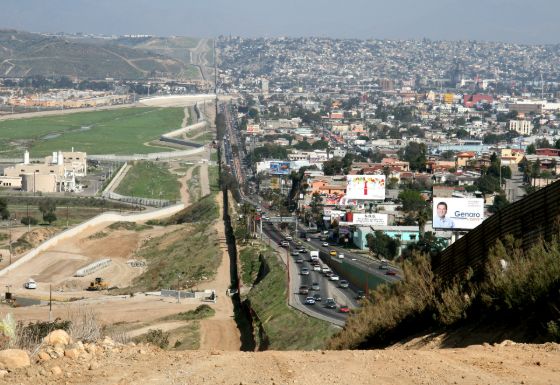
The immediate border area between Mexico's northern sates and the southern United States is known by many names:
- The Border Zone
- The Free Zone
- The Free Trade Zone
- The Liberated Zone
- The Hassle-Free Zone
- The Perimeter Zone
Initially, this area stretching 12-20 miles across the Mexican border, was designed to encourage travel and trade between Mexico and US travelers. As such, there were no FMM entry permit or Temporary Vehicle Import Permit (TIP) requirements. Passports were still a necessity, though.
This changed in 2015. The Mexican government required all those traveling to Mexico to get an FMM permit to enter the county. As it stands now, the only benefit to the Border Zone area is that a TIP is not required for vehicles that are not registered with Mexican documentation. Passports (or WHTI equivalents) and FMM are now always required for US citizens entering Mexico.
Still have questions about the requirements for crossing the U.S.-Mexico border? The Bureau of Consular Affairs website is the best source for further information about current regulations.
Should you need to obtain travel documentation quickly, be sure to visit our guides on how to expedite your passport and visa applications .
Top 5 Questions About Expedited Passport Couriers
1. How can you get a passport when you're in a hurry? 2. What exactly does a passport expediter do? 3. Are passport expediting services legitimate? 4. How can I identify a reliable passport expeditor? 5. Is expedited passport service worth it?

Get the Latest Updates

An official website of the United States government
Here’s how you know

Official websites use .gov A .gov website belongs to an official government organization in the United States.
Secure .gov websites use HTTPS A lock ( Lock A locked padlock ) or https:// means you’ve safely connected to the .gov website. Share sensitive information only on official, secure websites.

- For U.S. Citizens/Lawful Permanent Residents
Are You Planning a Trip to Mexico from the United States?
Warning: it's Illegal to Carry Firearms or Ammo into Mexico.
For border crossing information, tune into the port of entry's Loop Radio on 1620 AM. Report drug and alien smuggling. Call (956) 542-5811 in the U.S., 001800-0105237 from Mexico.
Prohibited/Permissible Items
- All articles acquired in Mexico must be declared.
- $800 exemption for gifts and personal articles, including one liter of alcoholic beverages per person over 21 every 30 days.
- Cuban cigars are prohibited.
- Check with U.S. Customs and Border Protection (CBP) about importing any medications prior to crossing into Mexico.
- CBP has a zero-tolerance policy on illegal drugs. Any type, in any amount may result in serious fines, seizure of vehicle, federal record and/or imprisonment.
- Switchblade knives, sea turtle boots or any other articles of endangered species (i.e. spotted cats, coral, crocodile, elephant, etc) are prohibited.
Prohibited/Permissible Agricultural Items
- Most fruits are prohibited (No oranges or apples)
- Do not take U.S. fruits and meats to Mexico-You cannot bring them back.
- Before you go to Mexico, ask a CBP Officer for a list of items you can bring back.
- Fines of $50 to $1,000 may result if you fail to declared agricultural items.
Texas Alcoholic Beverage Commission
- You must be 21 years of age to possess alcoholic beverages, if you are not 21, the alcohol will automatically be confiscated.
- One liter of alcohol and one case of beer may be imported per person every 30 days.
- No ID=no liquor. You must prove that you are 21 or older. If you show false or altered personal identification, the ID will be confiscated and you will be prosecuted.
- If you are 18 or over one carton of cigarettes may be imported.
- It is illegal in Texas to consume or possess with intent to consume alcoholic beverages in a public place on Sundays between 2:15 a.m. and noon or on any other day between 2:15 a.m. and 7 a.m.
- You are required to pay state tax on all alcoholic beverages and all cigarettes imported into Texas.
Do you need a visa to go to Mexico?

Oct 24, 2023 • 4 min read

Find out if you can apply for a working holiday visa in Mexico © Thomas Barwick / Getty Images
Mexico is a vibrant country full of incredible culture and wonderful people – no wonder it's so continuously popular with visitors.
But navigating tourist permits, visas and officialdom can be daunting when you’re headed to a foreign country, especially one that revels in red tape. Have no fear! Here’s exactly what you need to know about entry requirements for Mexico .
Who doesn't need a visa for Mexico?
Citizens of the US, Canada, EU, Israel, Japan and dozens of other countries are among those who do not require a visa to enter Mexico as tourists.
The same goes for any visitor, regardless of nationality, who is a permanent resident of or has a valid visa from the US (including an H1-B visa), Canada, the United Kingdom and any country in the Schengen Area or Pacific Alliance.
Notwithstanding visas, all foreign visitors must have a passport with at least six months validity and a completed Forma Migratoria Múltiple (FMM), Mexico’s tourist card or stamp.
Where do I get an FMM?
The paper version of the FMM is gradually being phased out across Mexico and replaced with a passport stamp. However, when needed, FMM forms are available at border crossings , international airports and ports ; if you’re flying to Mexico, the form will be provided to you on-board your aircraft. The FMM form can also be completed online , printed and presented to immigration officials.
Processing an FMM costs US$28, which is paid on the spot at borders and ports or is integrated into the cost of airline tickets under “fees and surcharges.”
Upon entering Mexico, immigration officials stamp the FMM or your passport, adding the number of days you’re permitted to stay. Officials can approve up to 180 days but often grant less. Be sure to ask for the number of days you’ll need to cover your visit!
When you leave Mexico, you must surrender your FMM, if it’s a paper version. Keep it safe. If you lose it, you’ll face a US$40 fine.
The requirements are a little different if you're entering Mexico by land:
- FMMs are free for visitors staying less than seven days
- FMMs are not required for visitors who stay less than 72 hours in the " Zona Libre " or "Free Zone" – the areas 20 to 26 km (12 to 16 miles) south of the US border
- If you're entering through the Zona Libre but are planning to travel beyond its limits, request an FMM form when crossing the border. If you forget, you’ll be stopped upon return to the Zona Libre and made to pay for the FMM. If departing Mexico from beyond the Zona Libre , you may be fined if you don’t have an FMM.

Visitors requiring a visa
Chinese, Indian, Russian and South African citizens are among those who are required to have a tourist visa to enter Mexico . In addition to having a valid passport, the following must be submitted in person at the nearest Mexican embassy or consulate:
- Visa application form
- A color passport photograph
- Proof of ties to an origin country (eg, a letter certifying employment or full-time study)
- Proof of economic solvency (eg, three months of bank statements or investments)
- Approximately US$51 fee (cash or bank transfers only)
Appointments for tourist visas at Mexican embassies and consulates must be made online with the Secretaría de Relaciones Exteriores . At the pre-scheduled time, the submitted documents will be reviewed, biometric data taken (photo and fingerprints) and an interview conducted by a consular agent.
Once approved, a tourist visa is valid for up to 180 days. Upon entry to Mexico, travelers with tourist visas must also have an FMM.
Can I extend my stay in Mexico?
It's no surprise that many visitors wish to extend their visa and see more of Mexico. How you do that will depend on the details of your particular visit.
If your FMM was issued for less than 180 days, you can request an extension at an immigration office . Be sure to apply well before your FMM expires! Documents needed include a valid passport, valid FMM, valid tourist visa (if necessary) and proof of sufficient funds to remain in Mexico for the intended length of stay.
If your FMM was issued for 180 days, you'll need to leave Mexico and re-enter – this triggers the issuance of a new FMM. Most travelers opt to visit a neighboring country for just a couple of days before returning.
Travelers with tourist visas should seek an extension or apply for a new visa at an immigration office. Be sure to start the process well before the visa expires, as it may take some time to process the paperwork.

Can I take a working holiday in Mexico?
Mexico offers a working holiday visa called a " Visa Temporal – Vacaciones y Trabajo ," wherein certain foreign nationals are permitted to accept paid work in Mexico for up to 180 days. Those include citizens, aged 18 to 30, from Canada, Chile, Colombia, France, Germany, New Zealand, Peru and South Korea.
Extensions are not permitted and the visa cannot be converted into a work visa. To obtain this visa, schedule an appointment at your nearest Mexican embassy or consulate via the website of the Secretaría de Relaciones Exteriores .
This article was first published Jun 30, 2021 and updated Oct 24, 2023.
Explore related stories

Sustainable Travel
Apr 29, 2024 • 11 min read
Step away from the gas pump and strap on your seat belt: these are the best US road trips for electric vehicles.

Apr 19, 2024 • 10 min read

Feb 19, 2024 • 7 min read

Feb 7, 2024 • 5 min read

Jan 27, 2024 • 15 min read

Dec 28, 2023 • 5 min read

Dec 27, 2023 • 8 min read

Dec 15, 2023 • 7 min read

Nov 5, 2023 • 11 min read

Oct 13, 2023 • 8 min read
Travel Documents You Need to Visit Mexico
Corbis / Getty Images
Passports have been mandatory for air travel between the United States and Mexico since the Western Hemisphere Travel Initiative came into effect in 2007. But for travel by land and sea, there are a few alternative travel documents which are still accepted in some situations.
Traveling to Mexico With Children
When traveling to Mexico, U.S. citizens, Canadians, and other foreign visitors should check what identification and travel documents are valid and necessary. If you are traveling to Mexico with children , there are some special requirements you may need to complete before you book your trip.
U.S. Citizens
- Passport: A passport is hands-down the best form of identification and proof of citizenship. It is highly recommended that you get a passport to travel to Mexico. If you'll be entering the country by air, it's necessary. If for some reason you are unable to get a passport or do not want to, you will need one of the following documents to travel to Mexico by land or sea. These documents are acceptable travel documents for all United States citizens.
- Passport card: Issued by the U.S. Department of State, this passport substitute is credit-card sized and valid for entry into Mexico by land or sea. The passport card is not accepted for air travel . This passport card can also be used for land and sea travel to Mexico, Canada, Bermuda, and the Caribbean. A passport card also costs less than a passport, however, a passport is more useful overall, especially if you plan on traveling outside of North America.
- Enhanced Drivers License: Enhanced Drivers Licenses are proof of citizenship and identity. These special drivers licenses are valid for travel to Mexico by land or sea but are not valid for air travel. It's important to keep in mind that these are only available in some states, including Michigan, New York, Vermont, and Washington. You will need to research your individual state licensing department for specific details.
- SENTRI Card: The U.S. Customs and Border Protection issue the SENTRI Card to pre-approved travelers who cross the U.S./Mexico border frequently. It has the added benefit of access to dedicated commuter lanes for crossing the border. The card is valid for five years.
- FAST card: The FAST card provides expedited travel to pre-approved commercial truck drivers between the U.S. and Canada, and U.S. and Mexico borders through dedicated lanes.
U.S. Permanent Residents
For permanent residents of the United States, the I-551 Permanent Resident card is required for return to the US. For entry into Mexico, you will need to present a passport, and depending on your country of citizenship, possibly a visa as well.
Canadian Citizens
Mexico is the second most popular tourist destination for Canadian travelers . Since 2010, a new requirement was put into place, which states that a passport is required for Canadian citizens traveling to Mexico.
Citizens of Other Countries
A passport is necessary, and in some cases, a visa is also required for citizens outside of the US. Contact the Mexican embassy or consulate nearest you for more information about the requirements specific to your situation.
What Documents Do I Need for Mexico Travel?
Do I need a passport to travel to Mexico?
Marriage Laws for Caribbean Destination Weddings
Passport Requirements for Driving to Canada
Do Children Need a Passport to Visit Canada?
Top 9 Mexico Travel Myths Debunked
What Travel Documents Are Needed for Your Caribbean Vacation?
What to Know About Visiting Mexico During Spring Break
What You Need to Know About Visiting Canada From the U.S.
How to Find Your Nearest US Passport Office
Vancouver to Seattle Border Crossing: Which Travel Documents do I Need?
Tijuana, Mexico Visitor's Guide
Passport Requirements for Canadian Citizens Traveling to Mexico
Passports and Mexico Entry Requirements for Children
What to Do in an Emergency in Mexico
Travel to Africa and the Middle East: A Reopening Timeline, Country by Country
Mexico Entry Requirements for U.S. Citizens
Mexico Visa Needed
(for stays of up to 180 days)
Tourist Card (FMM) Needed
(if traveling by land)
Mexico has a number of entry requirements that citizens of the United States must meet when visiting the country.
US citizens planning to travel to Mexico should first check if they require a visa to cross the border, according to the Mexican visa policy.

What U.S. Citizens Need to Travel to Mexico
American citizens must have a few essential documents to travel to Mexico. These include:
- US passport
- FMM tourist card (for land travel)
- Mexican visa (if applicable)
A visa for Mexico may not be required for US passport holders. This depends on the period of stay and your reason for traveling.
U.S. passport requirements for Mexico
Your US passport must meet certain criteria when traveling to Mexico. It must not expire for at least 6 months after the date of arrival.
If your passport is due to expire sooner than this, renew it before getting the FMM and traveling to Mexico.
Do U.S. citizens need a Tourist Card for Mexico?
Americans must register for a Mexico tourist card to visit the country for the following reasons:
The tourist card required by visitors from the US is called the Forma Migratoria Múltiple (FMM) .
The FMM is not a visa. It’s an entry requirement for all foreign visitors, including Americans . It’s mandatory if you plan to travel more than 20 kilometers into Mexican territory and stay more than 72 hours.
A Mexican tourist card for United States citizens is a single-entry document. It becomes invalid once you leave Mexico. You need to get a new FMM for every trip to the country.
Do U.S. citizens need a Mexican visa?
Tourists and business travelers from the United States can stay up to 180 days visa-free in Mexico. Americans can also transit in Mexico for up to 30 days without a visa.
The same is true for non-US nationals who hold a valid US visa or Green Card . These documents must be brought as proof to gain visa-free entry to Mexico.
Citizens of the United States who plan to work, study, or engage in other non-tourist or business activities need a visa for Mexico .
Americans also need a visa to stay in Mexico for more than 180 days.
How Can U.S. Citizens Apply for a Mexico Tourist Card?
US citizens can now complete the tourist card form online. This saves time and the inconvenience of dealing with paperwork during their journey or at border control.
The streamlined electronic form greatly expedites the process of entering Mexico .
Mexico's Immigration Policy for U.S. Nationals
Citizens of the United States of America must comply with Mexico’s immigration policy when traveling to the country.
US nationals must :
- Have the correct documentation
- Comply with customs and border regulations
- Leave Mexico within the time permitted (180 days for visa-free visitors)
Americans must not :
- Bring any unauthorized or illegal items into Mexico
- Overstay the terms of their visa or visa exemption
Do Americans need vaccinations for Mexico?
Mexico’s travel rules for US passport holders do not include any mandatory vaccinations .
However, the US CDC highly recommends being immunized against the following before traveling to Mexico:
- Hepatitis A and B
Malaria is present in certain areas of Mexico. US nationals are advised to bring anti-malaria medication if staying in these regions.
What Do U.S. Citizens Need to Leave Mexico?
When leaving Mexico , you’re required to present the tourist card alongside your passport.
Therefore, it’s important to keep the slip of paper safe during the entirety of the stay in the country.
The validity of the FMM document for Americans begins from the moment it is stamped at the Mexican border . If the FMM is lost or stolen before arriving at immigration control in Mexico, you can obtain another form online.
If a validated Mexico FMM for US citizens is lost or stolen within Mexico, you should report the theft to local police. You must then include the subsequent police report in the application for a replacement tourist card. You can do this at an Instituto Nacional de Migración office within Mexico.
The U.S. Embassy in Mexico
The US Embassy in Mexico is located in Colonia Cuauhtemoc, Mexico City. The embassy provides a variety of services to American citizens in Mexico.
These include emergency assistance in cases of:
- Loss of passport
- Arrest of a US Citizen
- Death of a US Citizen
- International Parental Child Abduction
The embassy can provide emergency financial assistance and support to US citizens who are victims of crime. It is also authorized to issue certifications of US citizenship for eligible individuals born abroad to American parents, among other services.
Register with the U.S. Embassy in Mexico
It is now possible for US citizens and nationals to register with the nearest embassy or consulate when traveling in Mexico.
By registering with a US embassy in Mexico, travelers can:
- Make informed travel plans based on information received from the embassy, such as safety and security advice.
- Be contactable in the case of emergency: the US embassy will get in touch in circumstances such as a natural disaster or family emergency.
- Help family and friends to get in contact in an emergency.
US passport holders can enrol when registering for the tourist card on this website . Simply select the Embassy Registration option on the payment page.
You can also search using these:
Discover Mexico A-Z

- News & Offers
- Mexico Guides
- Mexico Features
- Free eBooks
- Free Guides
Travel Experiences
Trip planning, travel destinations, destination highlights, mexico lifestyles, living & lifestyle, lifestyle planning, real estate, healthcare & wellbeing, leisure assistance, lifestyle assistance, insurance coverages, property assistance, about mexperience, mexico essentials, discover more, procedures for entering and leaving mexico.
There are some straightforward paperwork procedures to engage with when you arrive to, and depart from, Mexico. This article describes them

When you are arriving in or departing from Mexico, there are some straightforward paperwork procedures that you will need to engage with.
Specific entry and exit procedures exist for foreign visitors, foreigners with resident visas and resident cards, as well as Mexican nationals and naturalized foreigners.
This article describes the procedures you need to engage with when you arrive to, and leave from, Mexico.
Foreign visitors to Mexico
If you hold a passport issued by one of the many countries on Mexico’s “ no visa required ” list,* you don’t need to apply for a visa to visit Mexico. You can, instead, complete a Visitor’s Permit, also known as a FMM , at your port of entry.
There is a ~US$25 fee for the permit, which is usually included in your airfare’s “fees and taxes” if you fly in to Mexico; if you drive-in to Mexico, the fee is waived if you depart within 7 days of your arrival date. The visitor’s permit is valid for stays up to 180 days.
Paper FMM forms are being phased out and it’s likely that the FMM will be stamped into your passport instead.
However, if you are given a paper FMM when you entered Mexico, don’t lose the half of the form that is handed back to you at immigration as you’ll need it to exit the country.
If you lose the permit; or keep the permit when you leave; or over-stay the number of days limit written on the permit , you’ll face some additional procedures: see this article for details about those situations.
Automated lanes for TOURISTS entering Mexico
Airports in Mexico City and Cancún have automated kiosk lanes where TOURISTS may register their entry to Mexico by scanning their passport on a machine. The machine will give you a receipt with a QR code that you must scan with your smartphone to get a digital version of your FMM. You’ll need to do this before you leave Mexico.
You can only use these automated lanes if you are a passport holder of the US, Canada, Japan, UK and some other European countries; you are over 18; and you are not traveling with minors. See this government page for more details .
Foreigners with a resident visa sticker in their passport
If you are arriving in Mexico with a resident visa stamp (sticker) in your passport provided by a Mexican Consulate abroad, you might need to fill out the Visitor’s Visa on arrival (see blue box above about phasing out of paper FMM forms).
Show the immigration officer the page in your passport with the residency visa stamp and double-check that the officer checks the box on the form that reads “Canje” (exchange) NOT “ Vistante .” (If the officer admits you as a visitor/tourist, this will cause problems when you attend the immigration office to exchange your resident visa stamp for a residency card.)
If you don’t have to complete the paper FMM form at your port of entry, the official will place a stamp in your passport, instead, and mark ‘Canje’ to indicate that you need to exchange your visa for a residency card. You then have 30 days to attend the immigration office and exchange your resident visa stamp for a residency card .
Foreign residents with resident cards
Foreign residents who are in possession of a Residente Temporal or Residente Permanente card (or one of the old FM3 or FM2 residency permits) need to present their passport and resident card to the Immigration Officer at the port of exit (e.g. airport or border crossing) before they depart.
You must use your residency card to exit and re-enter the country if you are legally resident in Mexico.
If you have lost or damaged your residency card , you need to apply for a replacement.
Some airports no longer issuing Exit Stamps
Readers have told us that some airports (Puerto Vallarta and Guadalajara) are no longer issuing Exit Stamps to holders of residency cards. However, other airports (Mexico City) continue to issue Exit Stamps.
We recommend that if you hold a residency card and leave Mexico you continue to attend an INM office or kiosk at the exit port and ask for an Exit Stamp. You might be told that it’s no longer required.
There has been no official notice of a change of policy, but we will keep this page updated with new information as it becomes available. [January 2024]
Paper FMM forms being phased out
Until recently, residents always needed to complete a paper form (FMM) , which is used by the government to record statistics. Depending on what port you exit from, this may no longer be required and officer will simply stamp your passport. See also: Phasing out of paper FMM forms .
Returning to Mexico as a legal resident
When you return, you must present the immigration official with your resident card and the exit FMM form’s date-stamped copy issued to you at exit, or the exit stamp that was placed in your passport.
Note: If you re-enter Mexico as a tourist (Visitor) when you have residency in Mexico, you at are risk of losing your legal residency status.
Lost/missing FMM form: If you were given a paper copy of the FMM and lose the half that was handed to you when you left Mexico, you’ll need to re-complete a FMM when you return to Mexico and explain to the immigration official that you lost the half that was given to you when you departed.
Lost passport with exit stamp: If you had a stamp in your passport when you left Mexico and you lose that passport, explain this to the officer when you return to Mexico. If you update your passport, take the previous (cancelled) passport with the stamp in it to show the immigration officer.
Expired residency card: If you hold a temporary residency card, be sure to check its expiry date. If you leave Mexico with an expired card, it might be confiscated at the port of exit. If you are outside of Mexico when it expires, you have a limited time frame to return to Mexico to get it renewed. See this article for details .
Mexico is phasing out paper versions of the FMM
The paper versions of the FMM are being gradually phased out and replaced with a stamp in your passport.
Read this article for further details .
Mexican nationals and naturalized foreigners
If you are in possession of Mexican passport, you will need to complete a form before you exit the country known as the Formato Estadístico para Mexicanos (FEM). The government uses this to record statistics of Mexican nationals traveling abroad.
Lost visitor/tourist permit, lost residency card
If you are visiting Mexico as a visitor/tourist and you lose your visitor’s permit, you will need to attend a local immigration office (in a town or city or at the airport) to apply for a replacement; there is a fee of around US$40 involved—the local immigration office will advise you of the current replacement fee.
Lost passport with exit stamp: If you had a stamp placed in your passport when you arrived in Mexico and you lose that passport, visit the local immigration office to explain this and to get guidance.
Updated passport: If you had a stamp placed in your passport when you arrived in Mexico and you update your passport while you are in Mexico, take the previous (cancelled) passport with the stamp in it to show the immigration officer. If you don’t have the cancelled passport visit your immigration office for guidance.
Tourist permit replacement process: You will be required to undertake some paperwork and to pay the fee. This process can take up to an entire day of your time. Take good care of your visitor’s permit and, in the event of its loss, we recommend you allow a whole day in your schedule to secure a replacement.
Lost residency cards: If you are resident in Mexico and lose your residency card, learn about how to apply for a replacement residency card in Mexico .
*If you are a passport holder of a country that is not listed on the “no visa required” list, read this article for further information and advice about applying for a visa before you travel to Mexico.
Further information
Here is some further information you may find helpful:
- For a summary of the documentation required to enter Mexico, see Documents required for travel and entry to Mexico
- Many people don’t need to pre-apply for a visa to visit Mexico, but some do. Read Do I need a visa to visit Mexico? for details.
- You can get full details about immigration procedures on your arrival in Mexico on our comprehensive guide to Mexico Entry Requirements .
Obtaining legal residency in Mexico
For information about long-term residency, including permits for living, retirement, and working in Mexico, read this article about typical routes to obtaining residency in Mexico and download a copy of our comprehensive Mexico Immigration Guide (eBook) .
Mexico in your inbox
Our free newsletter about Mexico brings you a monthly round-up of recently published stories and opportunities, as well as gems from our archives.
22 Comments
Dear Mexperience,
I am an American holding a Residencia Permanente. I live part time in Mexico. Could you tell me the Pros and Cons of obtaining Dual Citizenship? Thank you very much.
Hi Robert, See this article for details: https://www.mexperience.com/becoming-a-naturalized-mexican/
My husband and I have decided not to exchange our temporary residency cards for permanent residency cards. This is mainly due to our advanced age (81 and 72) and the fact that we only stay in Mexico a maximum of 4-5 months per year. We are currently in Mexico and our cards expire 3 weeks before we return to Canada. Do we need permission to leave the country?? We like to avoid visiting a busy INM office during a pandemic. Your advice is very much appreciated.
Hello Maryanne,
You can leave Mexico with an expired Temporary Residency card, however you will need to pay a fine at the airtport. (Note that you’ll have to go to the bank to pay the fine, so build-in extra time for that on your departure date.) The fine varies depending on circumstances and is a maximum of $8,000 Mexican pesos.
If you want to avoid the fine, you need to leave Mexico with a non-expired residency card, or if it’s expired, you need to enter into a renewal procedure.
You can find out more about expired permits here: https://www.mexperience.com/expired-mexico-resident-permit/
Traveling to Cancun in late February, 2021. My passport expires in late July, 2021. Is that sufficient or should I renew? Thanks
Hi Elizabeth
We recommend your passport is valid for at least 6 months from the date of entry. Admision to Mexico depends on the official at the border. If your passport does not have 6 months of valid time left, and you can provide evidence of your departure before the passport expiry date, the official may allow you in.
See the blue information box on this page for more details: https://www.mexperience.com/mexico-essentials/mexico-entry-requirements/#ReqTourists
So, if you have Schengen visa, do you still need FMM filled out ?
Hi Ana, all visitors arriving in Mexico need to complete a FMM, regardless of whether they have a Schengen visa.
My brother in law is a permanent resident of the USA and living in houston. What does he need to travel By plane into mexico City and back?
Hello, I entered mexico in texas at the pharr bridge. But when i got to the other side, there were no people. I had to stop at a lift gate arm, where it seemed my picture was taken by a machine, and then the gate arm lifted and I drove on through. I kept expecting to be stopped to have my passport stamped and pay my vehicle deposit and get my forma de immigration. But there was noone there and no where to stop and no signs. Before I knew it, I was in mexico driving down the highway on my way to oaxaca amd chiapas Was there somewhere I was supposed to go? I was trying to follow the law and procedures, but somehow i dont think I did. Am I breaking the law? What comsequences can I expect? What shoukd I do? Thank you
If your vehicle has no TIP https://www.mexperience.com/temporary-import-permit-tip-vehicles-mexico/
And you don’t have a FMM https://www.mexperience.com/your-mexican-tourist-permit-fmm/
And you have driven past the ‘free zone’ then you and your vehicle are not legally present in Mexico.
You need to drive your vehicle out of Mexico and get yourself a FMM and and TIP (see links above).
We have airline tickets leaving out of Tijuana and my sons passport will not be here in time will he be able to still get the FFM permit with only a drivers license and Birth Certificate? We’re US citizens
Hello Deann, your son will need a passport to enter Mexico, and to board a flight. You can find further information here: https://www.mexperience.com/documents-required-for-travel-and-entry-to-mexico/
I am hoping to get some clarification on whether a felon from the U.S. is able to travel to Cabo. I see conflicting opinions on this so maybe you are able to give me accurate information. Are criminal records from the United States checked upon entry at the airport?
Hi Ann, You can find the answer to that question on our Immigration FAQs page here: https://www.mexperience.com/mexico-immigration-visas-faqs/
My name is Julita . Holding philippine passport. I am legally married to a mexican but his living in US..we want to live in mexico what is the best for me to do, first i need a visa . How to apply . Please i need your help. Thank you
Our Mexico Immigration Guide (free eBook download) contains detailed information about the requirements and procedures as well as the criteria: https://www.mexperience.com/ebook/mexico-immigration-guide/
If you’d like assistance with your application, consider our Immigration Assistance service; our associate can provide consulting to talk about your individual situation, suggest the best approach for your application, and also provide practical assistance as you make your way through the process–details here: https://www.mexperience.com/lifestyle/living-in-mexico/relocation-consulting-request/
Hello Mexperience. I’m in the process of buying a property in CDMX. Can I fly into Mexico to take care of things related to this purchase between Aug 1 to 9? Also, I have dual citizenship. Which is the most recommended way for traveling, as Mexican or as American? I have both passports. Thank you and look forward for some info. Regards.
Hello Jaime, There are no restrictions when you fly to Mexico, but check with the airlines for schedules and and policies they have in place. You can enter Mexico with your US or Mexican passport. There are no restrictions on American passport holders entering Mexico by plane.
Can you drive to/from Mexico without passport if you have a permanent resident card in the US?
Hi Erik, according to the current rules you need either a passport (air/land) or passport card (land only) to enter Mexico. You can find more details on this Mexperience article: https://www.mexperience.com/documents-required-for-travel-and-entry-to-mexico/
This article shares advice about what to do when you forget to give back your FMM (Visitor Permit): https://www.mexperience.com/blog/your-mexican-tourist-permit-fmm/
Comments are closed.
Documentation

Documents Required for Travel and Entry to Mexico
A reminder about the documentation that is required for travel and entry to Mexico whether you are visiting or...
Visitor Permit
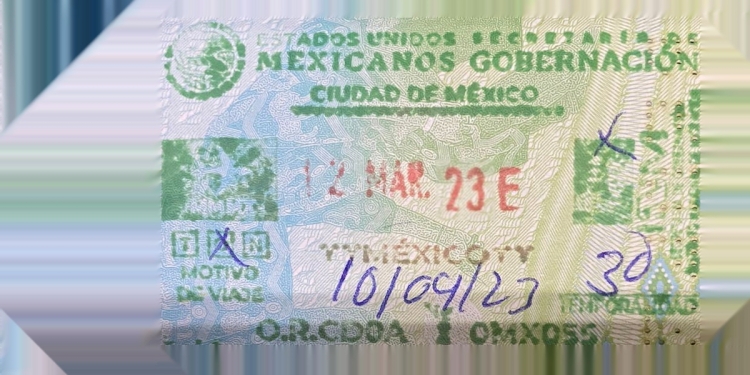
Learn About Your Mexico Visitors Permit, FMM
Mexico offers visitor permits for visits and short business trips lasting 180 days or less to passport holders on...
Paper Phase Out
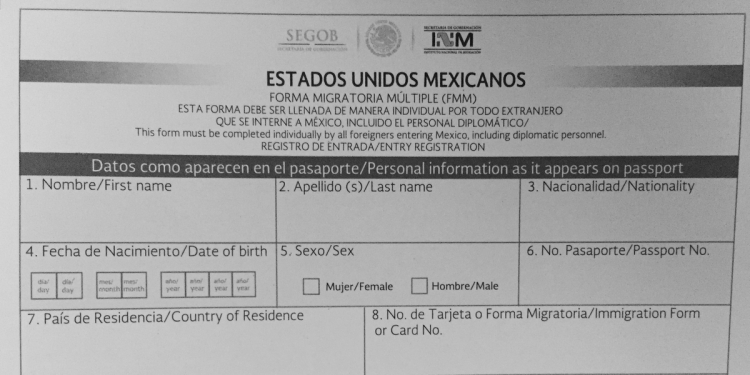
Mexico Phasing Out Use of Paper Visitor Permits (FMM)
Mexico’s immigration service has begun to phase out use of paper versions of the FMM—the multi-purpose visitor permits and...

Principal Routes to Obtaining Legal Residency in Mexico
This article describes principal routes foreigners take to apply for legal residency in Mexico, with references to additional information...
Residency Rights
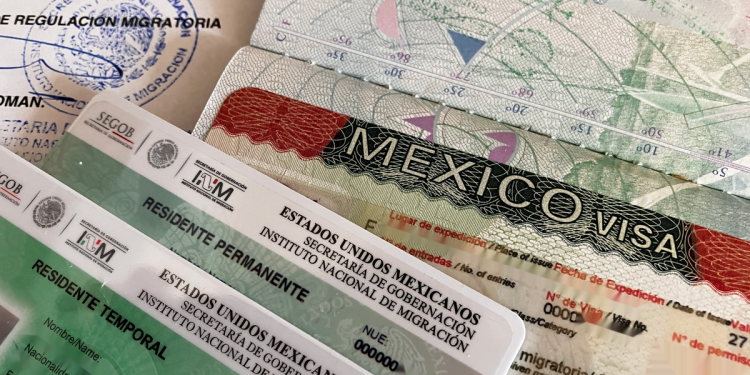
Rights & Obligations When You Have Legal Residency in Mexico
When you hold temporary or permanent legal residency in Mexico, you also have certain rights and obligations. This article...
Visa Exchange
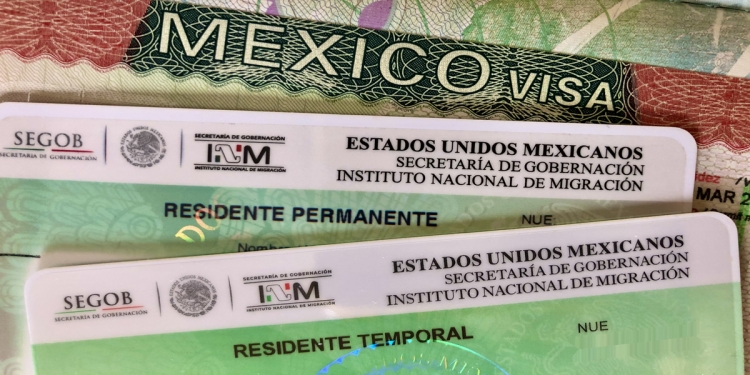
Exchanging a Mexico Residency Visa for a Card
When your Mexico residency application is granted, a visa sticker is placed in your passport. This sticker needs to be...
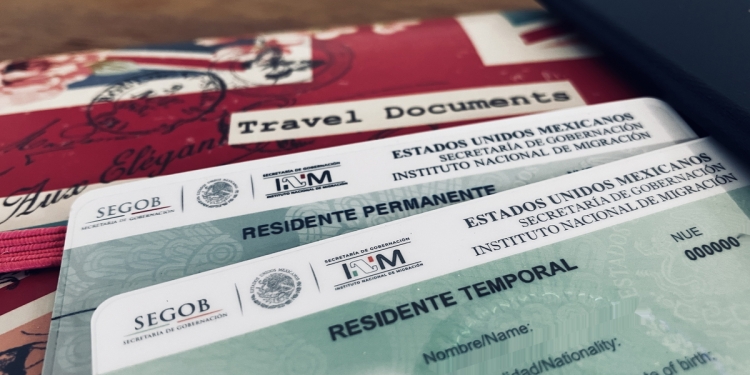
Replacing Your Lost or Damaged Mexico Residency Card
If you discover that your Mexico residency card is lost, or it becomes damaged beyond use, you'll need to...

Traveling with Minors to Mexico
Travel advisory about minors entering and leaving Mexico when they are traveling alone or without parents or a legal...

Volunteering in Mexico
This article explains what you need to know about visas if you plan to undertake some volunteer work in...
Mexico Entry Requirements
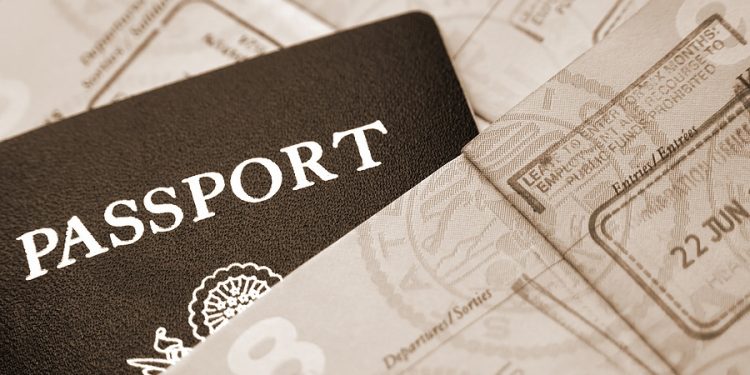
Mexico Entry Requirements—For Leisure, Business or Residency
This guide explains what you need to know about entry requirements when you are visiting Mexico for leisure, for...
Mexico Visa

Do I Need a Visa to Visit Mexico?
Do you need a visa to visit Mexico? This article explains who —and who does not— need to apply...
Please SAVE the PDF for your personal use.
Download again
My File Downloaded - Close this box

- Immigration
Mexico Visa Rules & Required Documents: What You Need to Know
When planning to travel to mexico, it's important to be aware of the visa rules and necessary documents. depending on your citizenship, you may need a visa or can enter visa-free. key documents include a valid passport, tourist card (fmm), and visa (if required). make sure to check the latest requirements before your trip..

Key Takeaways:
- Understand Mexico’s visa rules: Most travelers don’t need a visa, but a tourist card (FMM) is required for stays up to 180 days.
- Tourist Card (FMM): The FMM is mandatory for visa-exempt visitors and can be obtained upon arrival or online.
- Required documents: To obtain the FMM, you need a valid passport, completed FMM form , and proof of departure.
Understanding Mexico’s Visa Rules
Are you planning a trip to Mexico? Whether it’s for vacation, business, or perhaps a longer stay, it’s essential to be aware of Mexico’s visa rules and the documents you’ll need for your journey. Let’s dive into what you should know before packing your bags.
Do You Need a Visa to Visit Mexico?
For many travelers, entering Mexico doesn’t require a visa. Citizens of countries such as the United States, Canada, most European countries, Japan, and New Zealand, to name a few, can enter Mexico visa-free for short trips. However, you are required to fill out a Forma Migratoria Múltiple (FMM) upon arrival, commonly known as the tourist card, which allows you to stay up to 180 days.
What is the Tourist Card (FMM)?

The Forma Migratoria Múltiple (FMM) is a mandatory document for visa-exempt foreigners visiting Mexico for tourism, business, or transit purposes. It’s important to note:
- The FMM is free if your stay is less than seven days; otherwise, there’s a fee.
- You can obtain an FMM upon arrival at airports, border crossings, or online before your trip.
Documents Required for the FMM
To obtain your FMM, you’ll need to present:
Also of Interest:
Austria work visa: requirements, process, austria business visa: requirements, application process.
- A valid passport or passport card.
- Your completed FMM form.
- Proof of your planned departure from Mexico, such as a return flight ticket.
Remember to keep your FMM safe during your stay; you’ll need to return it when you leave the country.
For Other Types of Visas
If your country is not on the visa-exempt list, or if you are planning to work, study, or reside in Mexico for an extended period, you’ll need to apply for a visa. The documents generally required include:
- A valid passport with at least 6 months’ validity remaining.
- Completed Mexican visa application form.
- Passport photos with a white background.
- Documents proving your purpose in Mexico, such as a letter of invitation or enrollment in a study program.
- Proof of financial means to support your stay.
- Payment of the visa processing fee.
Remember, the requirements can vary depending on the type of visa and your country of origin, so it’s always best to check with the nearest Mexican embassy or consulate.
Why Follow the Rules?
Failing to comply with immigration regulations can result in fines, deportation, or even a ban on re-entering Mexico. As an example:
“It is pertinent to respect the length of stay granted by the FMM. Overstaying can lead to complications that are best avoided.”
Tips for a Hassle-Free Trip to Mexico
- Always check the latest entry requirements before traveling.
- Keep electronic and physical copies of your important documents.
- If applying for a visa, start the application process well in advance of your trip.
- Upon arrival, keep your FMM and passport within easy reach.
For official information and updates on immigration procedures, visas, and entry requirements into Mexico, you can visit the National Institute of Migration’s website or your local Mexican embassy’s site.
In summary, visiting Mexico is an exciting prospect, and with the proper knowledge of visa rules and required documents, your trip can be as smooth as it is memorable. Prepare well and enjoy all the vibrant culture, history, and landscapes Mexico has to offer!
Well, amigo, now you know the ins and outs of Mexico’s visa rules! Remember, if you’re planning a short trip, no worries, just grab that tourist card upon arrival. For longer stays or special circumstances, don’t forget to check the visa requirements. And hey, if you want more helpful info and updates, head over to visaverge.com. Happy travels, and hasta la vista, baby!
FAQ’s to know:
FAQ 1: Do you need a visa to visit Mexico?
No, citizens of countries such as the United States, Canada, most European countries, Japan, and New Zealand can enter Mexico visa-free for short trips. However, you are required to fill out a Forma Migratoria Múltiple (FMM) upon arrival, commonly known as the tourist card, which allows you to stay up to 180 days.
FAQ 2: What is the Forma Migratoria Múltiple (FMM)?
The Forma Migratoria Múltiple (FMM) is a mandatory document for visa-exempt foreigners visiting Mexico for tourism, business, or transit purposes. You can obtain an FMM upon arrival at airports, border crossings, or online before your trip. It is important to note that the FMM is free if your stay is less than seven days, otherwise, there’s a fee.
FAQ 3: What documents are required for the FMM?
To obtain your FMM, you’ll need to present a valid passport or passport card, your completed FMM form, and proof of your planned departure from Mexico, such as a return flight ticket. Remember to keep your FMM safe during your stay as you will need to return it when you leave the country.
What did you learn? Answer below to know:
- True or False: Citizens of the United States do not need a visa to visit Mexico.
- What is the purpose of a Forma Migratoria Múltiple (FMM) when visiting Mexico? a) To obtain a visa for an extended stay b) To prove financial means for the trip c) To grant visa-free entry for short trips d) To reserve accommodation in Mexico
- What are the potential consequences of overstaying the authorized duration granted by the FMM? a) No consequences, as there are no penalties for overstaying b) Deportation c) A fee waiver for future visits to Mexico d) Immediate eligibility for Mexican citizenship
Verging Today

The Dark Side of Desi Consultancies in the USA
Trending today, u.s. visa invitation letter guide with sample letters.
Learn how to write an invitation letter for a U.S. visa with detailed information and two sample invitation letters. Get…
How to Complete the DS-160 Form Online: A Step-by-Step Guide
Filling out the DS-160 form is a critical step for anyone applying for a nonimmigrant visa to the United States.…
Troubleshooting USTravelDocs Login Issues: How to Prevent and Fix Unexpected Logouts
Experiencing ustraveldocs login issues or frequent logouts? Learn how to prevent and fix ustraveldocs logout problems to streamline your travel…
H-1B 2025: Will There Be a Second Lottery?
The USCIS announced the completion of the initial H1B 2025 lottery round, utilizing a new selection method to deter fraud.…
Understanding the B1/B2 Visa 6 Month Rule: Stay Duration Explained for Multiple Entries
Learn about the B1/B2 visa 6 month rule and understand how it applies to your stay duration in the US.…
Top 10 B-1/B-2 Visa Interview Questions with Answers
Prepare for your B-1/B-2 Interview with these 20 sample questions and visa interview answers to boost your confidence and readiness.
Warangal Missing Student Rupesh Chandra Chintakindi Located in Arizona Jail: Latest Updates
Warangal Missing Student found in jail in Tucson, Arizona with $50,000 bail set. Shocking twist in the Tucson arrest of…
How NRIs Can Vote in 2024 Lok Sabha Elections: Your Guide to NRI Voting Rights
Discover how Non Resident Indians (NRIs) can vote in Lok Sabha Elections, contributing to Indian Democracy and influencing the diaspora's…
Required Documents for a U.S. Visitor Visa Interview
When preparing for a U.S. visitor visa interview, it is important to have the necessary documents in order. These typically…
Sample Letters For No Objection Letter for Visa Application
A No Objection Letter (NOC) is often a vital document for visa applications, indicating that an employer or educational institution…
Sign in to your account
Username or Email Address
Remember Me
Visa Traveler
Exploring the world one country at a time
Mexico tourist visa: Requirements and application procedure
Updated: October 31, 2023
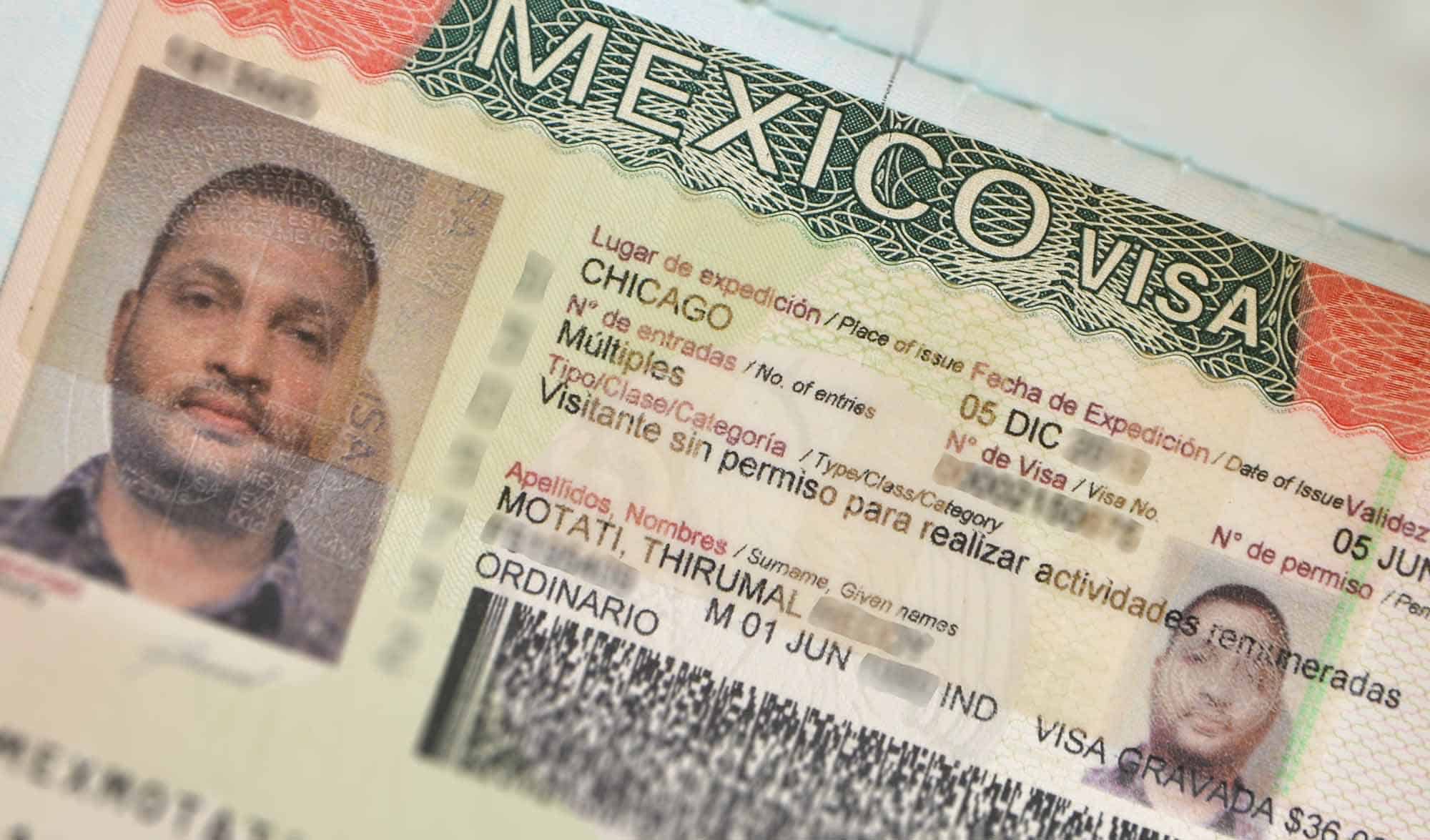
Mexico tourist visa requirements are clear and easy to understand. Mexico has a liberal visa policy offering visa EXEMPTION to many nationalities. Those who REQUIRE a visa are also exempt from visa if they hold a valid visa from the US, UK, Canada, Schengen or Japan.
Mexico visa application is fairly simple. It costs $44 USD and takes about two business days to process. Mexico tourist visa is valid for 180 days, multiple-entry.
Table of Contents

BONUS: FREE eBOOK
Enter your name and email to download the FREE eBOOK: The Secret to VISA-FREE Travel
Opt in to receive my monthly visa updates
You can unsubscribe anytime. For more details, review our Privacy Policy.
Your FREE eBook is on it’s way to your inbox! Check your email.

MEXICO TOURIST VISA REQUIREMENTS BY NATIONALITY
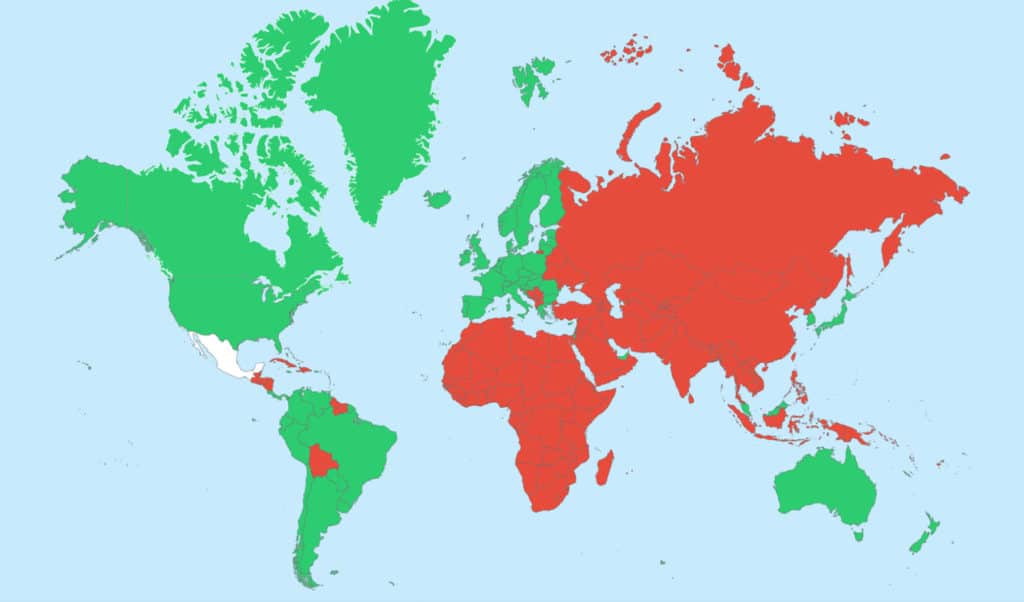
Minimum passport validity required to enter Mexico
- Passport must be valid for at least 6 months from the day of arrival
Visa EXEMPT nationalities
180-day entry.
- Liechtenstein
- Marshall Islands
- Netherlands
- New Zealand
- Sint Maarten
- South Korea
- Switzerland
- Trinidad and Tobago
- United Arab Emirates
- United Kingdom
- United States of America
Visa REQUIRED nationalities
- Afghanistan
- Antigua and Barbuda
- Bosnia Herzegovina
- Brunei Darussalam
- Burkina Faso
- The central African Republic
- Congo (Dem. Rep. of)
- Congo (Rep. of)
- Côte d’Ivoire
- Dominican Republic
- El Salvador
- Equatorial Guinea
- Guinea-Bissau
- North Korea
- North Macedonia
- Papua New Guinea
- Philippines
- Saint Kitts and Nevis
- Saint Lucia
- Saint Vincent and the Grenadines
- Salomon Islands
- São Tomé and Príncipe
- Saudi Arabia
- Sierra Leone
- South Africa
- South Sudan
- Timor-Leste
- Turkmenistan
- Vatican City
Visa EXEMPT with a valid VISA from the US, Canada, UK, Schengen or Japan
Visa is NOT REQUIRED for ANY nationality holding a valid visa from the United States, Canada, United Kingdom, Schengen or Japan for stays up to 180 days as a tourist.
Example: You hold an Indian passport with a US B1/B2 visa, both valid for more than 6 months. You can enter Mexico using your India passport and US B1/B2 visa. No need to apply for a separate Mexico visa.
Visa EXEMPT with a valid PERMANENT RESIDENT CARD from the US, Canada, UK, any Schengen country, Japan or any Pacific Alliance country (Chile, Colombia, Peru)
Visa is NOT REQUIRED for ANY nationality holding a valid permanent resident card from the United States, Canada, United Kingdom, Schengen, Japan, Chile, Colombia and Peru for stays up to 180 days as a tourist.
Example: You hold an Egypt passport with a US green card, both valid for more than 6 months. You can enter Mexico using your Egypt passport and US green card. No need to apply for a separate Mexico visa.
Visa EXEMPT for cruise passengers
Visa is NOT REQUIRED for cruise passengers of ANY nationality entering Mexico at maritime ports as part of the cruise trip.
Example: You are on a Caribbean cruise trip that will make a stop at Cancun, Mexico. You do not need any visa to enter Mexico at Cancun as part of your Caribbean cruise trip.
MEXICO TOURIST VISA APPLICATION PROCESS
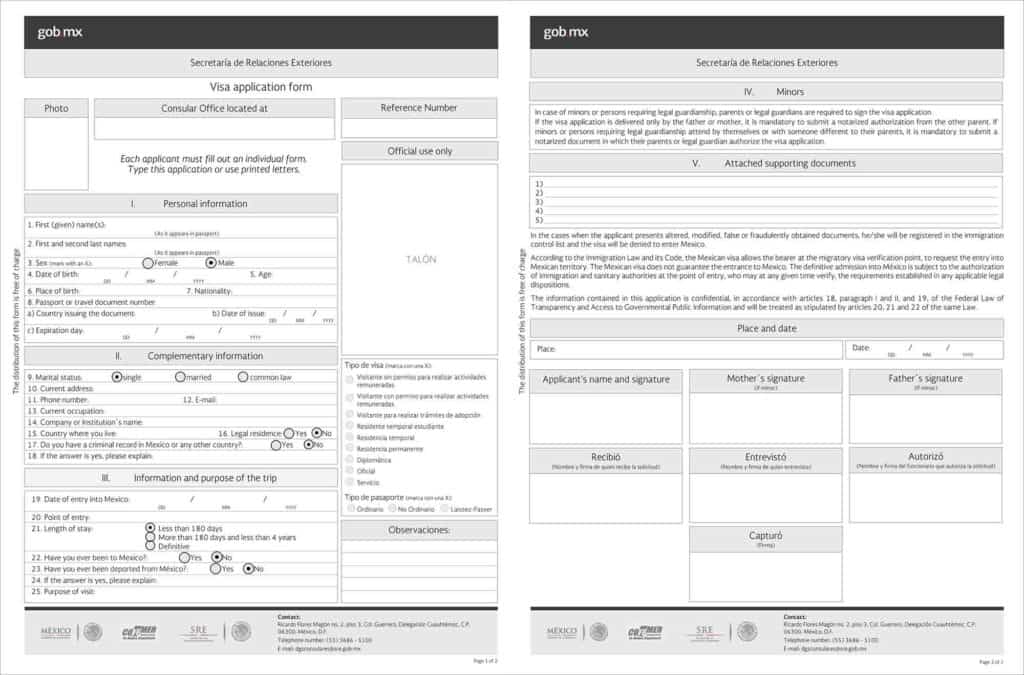
Check if you need a Mexico tourist visa from the “Visa Requirements” section above. Alternatively, you can check if a visa is REQUIRED or EXEMPT on the Ministry of Foreign Affairs of Mexico website.
Validity of Mexico tourist visa
Mexico tourist visas are valid for 6 months from the date of visa issue. Visas are usually multiple-entry.
Example: If your Mexico visa was issued on December 05, 2020, the visa will be valid until June 05, 2021.
When to apply for Mexico visa
You can apply for a Mexico visa up to 3 months in advance.
Example: If you plan to visit Mexico on April 15, you can apply for your Mexico visa on or after January 16.
How long can you stay in Mexico
The Mexico tourist visa allows you to stay up to 180 days in Mexico.
In most cases, immigration officers give 180-day entry. But there may be occasions where you will be given fewer days. Check your FMM form for the number of days you’re allowed to stay.
Example: If you entered Mexico on July 01, you will be allowed to stay till December 27.
PERSONAL EXPERIENCE When asked at the port of entry, I usually say that I’m in Mexico for 1 month. But if necessary I continue staying longer. In one instance, I stayed close to 180 days and it wasn’t a problem leaving or re-entering Mexico.
Application procedure
Mexico tourist visa application is a 5 step process.
- Prepare documents required
- Schedule visa appointment
- Pay visa fee
- Attend visa appointment
- Pick up Passport
1. Prepare documents required
The following documents are required for Mexico tourist visa.
- Completed Mexico visa application form
- One passport-size photograph
- Original passport
- Copy of the first and last page of your passport
- Original employment letter (must have been working for at least 1 year in the current company)
- Bank statements for the last 3 months
- Payslips for the last 3 months
- Copy of the visa/residence permit if applying in a third country (Example: if you hold an Indian passport and applying in the US, you have to provide a copy of your US visa)
1.2. Photo requirements
The photo must be 4.5cm x 3.5 cm with a white background, no glasses and the face covering 80% of the photo.
2. Schedule visa appointment
You must schedule your visa appointment at your nearest Mexican embassy or consulate using the MEXITEL visa appointment website. You cannot appear at the consulate without a prior scheduled appointment.
First, you will have to create an account in MEXITEL. You will need the following details to create your account.
- Surname/Family Name
- Mother’s Last Name
- Primary Phone
- Phone Number
After creating your account, you will have to select the country and the consulate. You will then see the calendar with available dates. You can select the date and time that works for you and schedule the appointment.
After you finish scheduling your appointment, you will receive a confirmation letter in your email. You must print this confirmation letter and carry it with you on the day of your appointment.
The Mexican embassy in India made a nice step-by-step guide on how to schedule visa appointments using the MEXITEL website.
NOTE Use Chrome browser if you can to schedule your appointment. MEXITEL website is not compatible with certain web browsers.
3. Pay visa fee
The Mexico tourist visa fee is $44 USD payable in local currency. You may end up paying a bit more or less due to the exchange rate. Keep in mind that the visa fee is non-refundable.
The payment method for the visa fee depends on the country and consulate. Some Mexican consulates accept cash payments within the consulate. Some require you to pay the fee at a designated bank in person or online prior to attending your appointment at the consulate. Check on your nearest consulate website for the exact procedure and fee.
4. Attend visa appointment
On the day of your visa appointment, you must appear at the Mexican consulate. If the consulate requires the visa payment to be made at the consulate, you will be instructed to pay the visa fee at the cashier.
You will then meet the consular officer. You must present your passport, documents and visa fee receipt.
The consulate office will review your documents and capture your biometrics such as photos and fingerprints. They will ask you a few questions to assess your background and purpose of travel.
If you are not eligible for the visa or do not meet the requirements, you will be told so. Your documents and passport will be returned back. This is not a rejection, so it will not hurt your future visa attempts for Mexico or any other country.
4.1. Visa processing time
Mexico tourist visa processing takes 2 working days. If there are too many applicants, the processing can take up to 10 working days. You will be told at the visa interview when to come back to pick up your passport.
05. Pick up passport
You have to go back to the Mexican consulate again in person to pick up your passport.
Keep in mind that passports cannot be mailed back to you. You also cannot send anyone else to pick up your passport. You must go back in person to pick up your own passport.
After you pick up your passport, verify the name and dates on your Mexico visa to make sure everything is correct.
ENTERING AND LEAVING MEXICO BY AIR
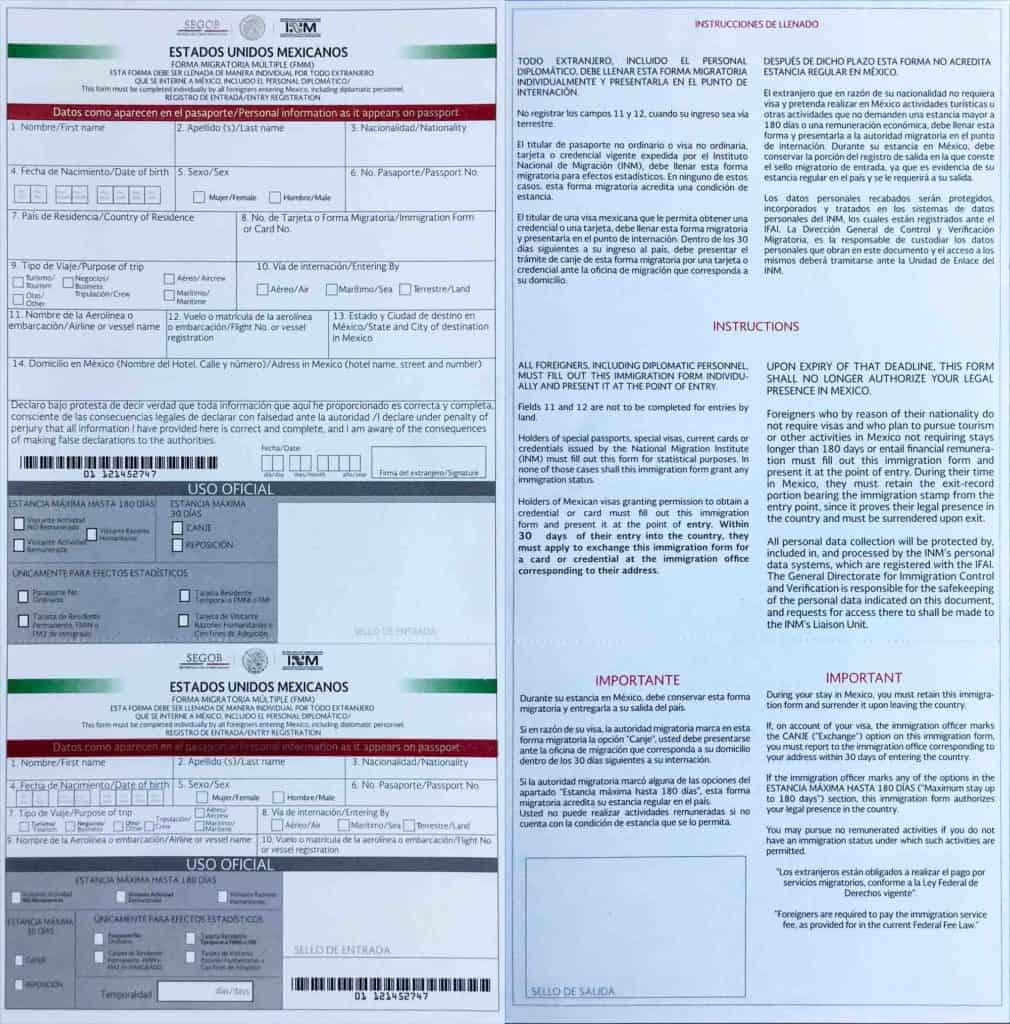
Entering Mexico by air
A Forma Migratoria Múltiple (FMM) is a Mexican immigration form similar to an arrival/departure card, also called a Mexico Tourist Card. Normally, an FMM card will be given to you on your inbound flight. You must fill this FMM card before you enter the immigration and customs at the first port of entry in Mexico.
At your first port of entry in Mexico, you have to go through passport control. You will be asked about your purpose of travel, whether it’s your first time in Mexico, etc. Your passport will be stamped.
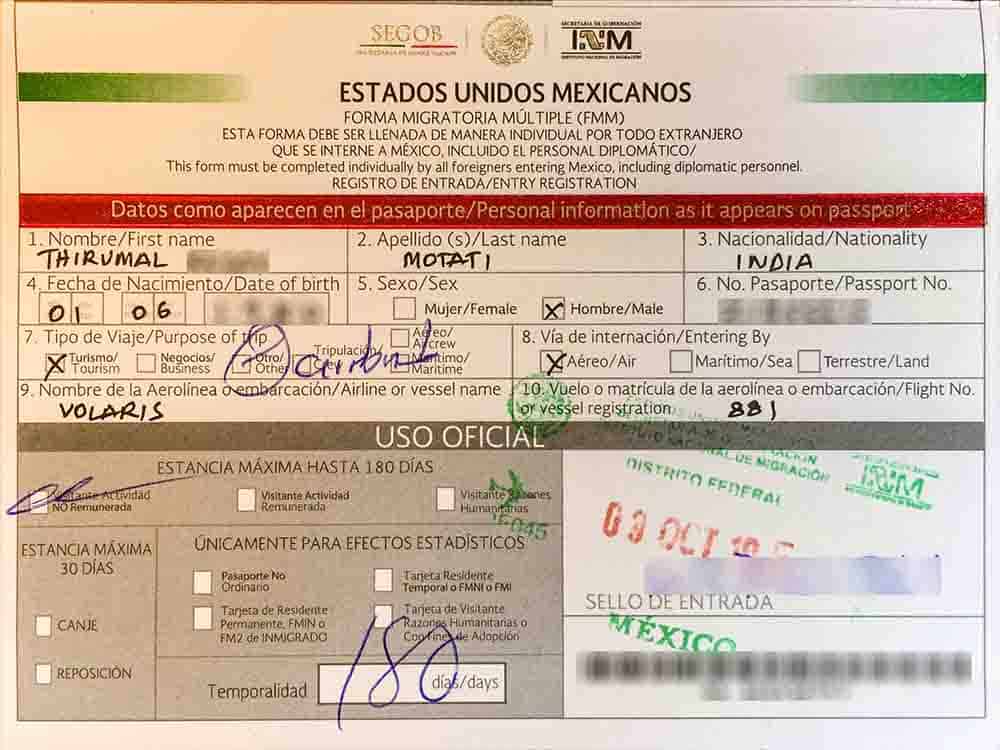
The number of days you will be allowed to stay will be marked on the FMM card. Usually, it’s 180 days but it can be less also. Verify the card right away to make sure you were given enough days for your trip.
PERSONAL EXPERIENCE I have entered Mexico by air at Mexico City, Guadalajara and Cancun airports. I was always asked how long I plan to stay in Mexico. I was never asked to show proof of my return ticket or hotel bookings.
IMPORTANT You must retain the FMM card while you are in Mexico. If you lose, you have to pay a penalty on your exit.
As always, carry a copy of your return ticket and hotel booking just in case. If you are traveling on a one-way ticket, don’t forget to get proof of onward ticket .

Leaving Mexico by air
You have to return the FMM card to the airline staff on your exit. If you lose your FMM card, you must pay a penalty. To avoid any penalties and delays on your exit, make sure to keep the FMM card safe while you are in the country.
PERSONAL EXPERIENCE I left Mexico by air at Mexico City, Guadalajara and Cancun airports. There was no exit passport control. The airline staff verified my FMM card at check-in and took it away at the gate before boarding.
ENTERING AND LEAVING MEXICO BY LAND
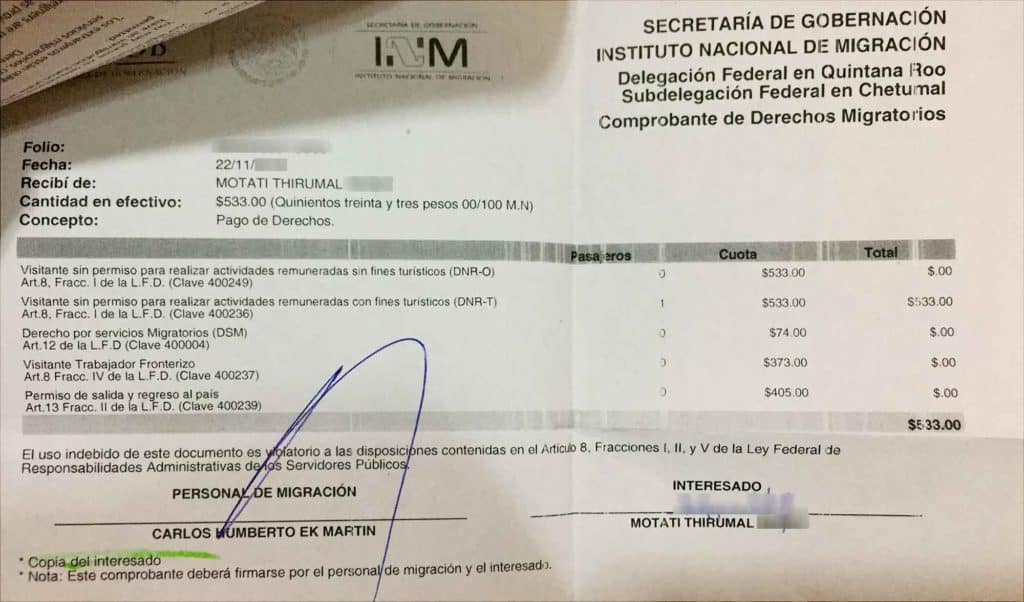
Entering Mexico by land
Grab and fill an FMM card at the immigration office. Present your passport, FMM card and cash for tourism tax.
You will be asked about your purpose of travel, whether it’s your first time in Mexico, etc. Your passport will be stamped. The number of days you will be allowed to stay will be marked on the FMM card. Usually, it’s 180 days but it can be less in some instances. Check the FMM card right away to make sure you were given enough days for your trip.
TOURISM TAX All tourists entering Mexico must pay a tourism tax. If you are flying into Mexico, your airline fare will include tourism tax. But if you are entering by land, you must pay tourism tax at the immigration office. The tourism tax is $594 MXN. It must be paid in cash in Mexican pesos only, but at some borders accept USD.
Leaving Mexico by land
You must present your original passport, FMM card and proof of tourism tax paid to the immigration officer.
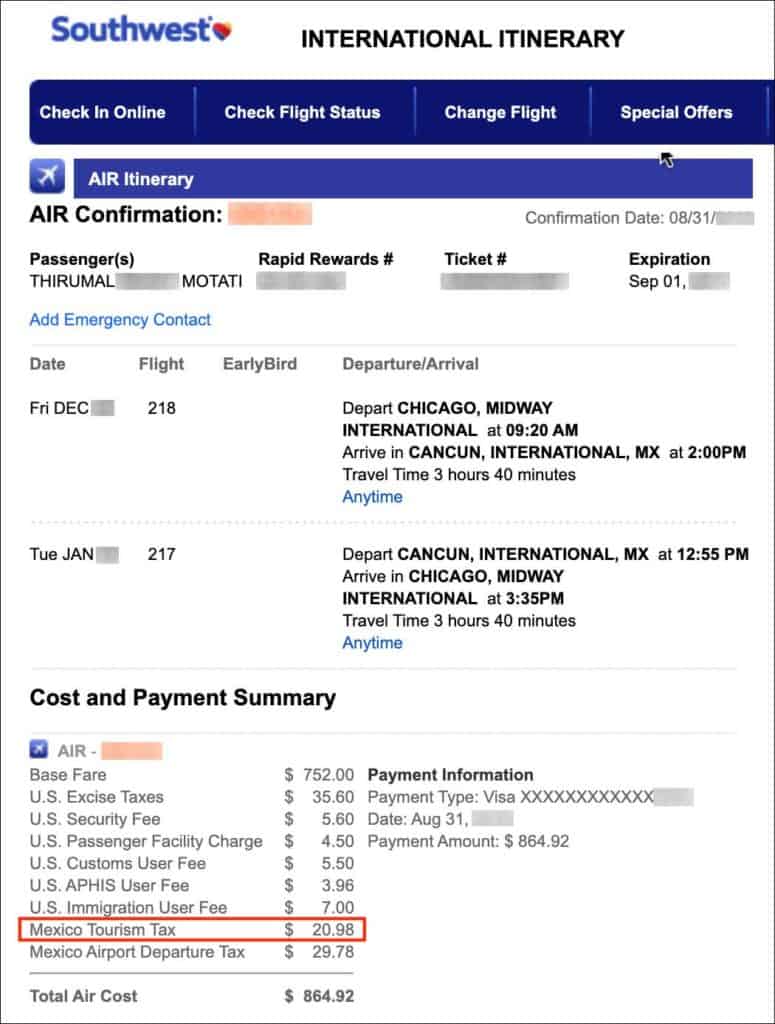
If you have entered Mexico by air, check your airline booking for itemized price details. You should see a line such as “Tourism Tax”. You can print your booking and show this as proof of the tourism tax paid when leaving Mexico by land. If you do not see tourism tax in your booking, you can email the airline requesting an itemized invoice. If the airline can’t provide you with one, you MUST pay tourism tax when leaving Mexico by land.
PERSONAL EXPERIENCE I left Mexico by land at Ciudad Cuauhtemoc near the Mexico/Guatemala border. I had a receipt of my tourist tax, so I presented my tourist tax receipt, FMM card and passport. The immigration officer took away the tourist tax receipt, and FMM card and stamped my passport with an exit stamp. It took about 5 minutes at the immigration office.
ENTERING AND LEAVING MEXICO BY SEA

Entering Mexico by sea
TOURISM TAX All tourists entering Mexico must pay a tourism tax. If you are flying into Mexico, your airline fare will include tourism tax. But if you are entering by sea, you must pay tourism tax at the immigration office. The tourism tax is $594 MXN. It must be paid in cash in Mexican pesos only, but some maritime ports accept USD.
PERSONAL EXPERIENCE I entered Mexico by sea at Chetumal near the Mexico/Belize border. I grabbed an FMM card, quickly filled and lined up at the immigration counter. It took a while to get through the immigration as there were many on the boat and there was only one immigration officer. I paid $533 MXN for tourism tax and received a receipt of payment.
Leaving Mexico by sea
If you do not have a tourism tax receipt or your airline booking doesn’t indicate it clearly, you will have to pay tourism tax when leaving Mexico by sea.
PERSONAL EXPERIENCE I left Mexico by sea at Chetumal near the Mexico/Belize border. I did not have a receipt for my tourism tax paid, so I had to pay the tourism tax at the port. I did not receive a receipt for tourism tax paid since I’m exiting and the receipt will not be useful anyway. The immigration procedure took about 10 minutes.

Mexico visa requirements are clear and easy to understand. Mexico offers visa EXEMPTION to many nationalities. Any nationality holding any visa from the US, UK, Canada, Schengen or Japan is also visa EXEMPT. The Visa application procedure is fairly easy, and quick and costs $44 USD.
WRITTEN BY THIRUMAL MOTATI

Thirumal Motati is an expert in tourist visa matters. He has been traveling the world on tourist visas for more than a decade. With his expertise, he has obtained several tourist visas, including the most strenuous ones such as the US, UK, Canada, and Schengen, some of which were granted multiple times. He has also set foot inside US consulates on numerous occasions. Mr. Motati has uncovered the secrets to successful visa applications. His guidance has enabled countless individuals to obtain their visas and fulfill their travel dreams. His statements have been mentioned in publications like Yahoo, BBC, The Hindu, and Travel Zoo.
PLAN YOUR TRAVEL WITH VISA TRAVELER
I highly recommend using these websites to plan your trip. I use these websites myself to apply for my visas, book my flights and hotels and purchase my travel insurance.
01. Apply for your visa
Get a verifiable flight itinerary for your visa application from DummyTicket247 . DummyTicket247 is a flight search engine to search and book flight itineraries for visas instantly. These flight itineraries are guaranteed to be valid for 2 weeks and work for all visa applications.
02. Book your fight
Find the cheapest flight tickets using Skyscanner . Skyscanner includes all budget airlines and you are guaranteed to find the cheapest flight to your destination.
03. Book your hotel
Book your hotel from Booking.com . Booking.com has pretty much every hotel, hostel and guesthouse from every destination.
04. Get your onward ticket
If traveling on a one-way ticket, use BestOnwardTicket to get proof of onward ticket for just $12, valid for 48 hours.
05. Purchase your insurance
Purchase travel medical insurance for your trip from SafetyWing . Insurance from SafetyWing covers COVID-19 and also comes with a visa letter which you can use for your visas.
Need more? Check out my travel resources page for the best websites to plan your trip.
LEGAL DISCLAIMER We are not affiliated with immigration, embassies or governments of any country. The content in this article is for educational and general informational purposes only, and shall not be understood or construed as, visa, immigration or legal advice. Your use of information provided in this article is solely at your own risk and you expressly agree not to rely upon any information contained in this article as a substitute for professional visa or immigration advice. Under no circumstance shall be held liable or responsible for any errors or omissions in this article or for any damage you may suffer in respect to any actions taken or not taken based on any or all of the information in this article. Please refer to our full disclaimer for further information.
AFFILIATE DISCLOSURE This post may contain affiliate links, which means we may receive a commission, at no extra cost to you, if you make a purchase through a link. Please refer to our full disclosure for further information.
MORE VISA GUIDES

UNITED KINGDOM

VIEW ALL VISA GUIDES
- Cookie Policy
- Copyright Notice
- Privacy Policy
- Terms of Use
- Flight Itinerary
- Hotel Reservation
- Travel Insurance
- Onward Ticket
- Testimonials
Search this site

Travel Guide
- Things to Do
- Entry Requirements & Customs
- Getting Around
- Visitor Information
- Tips on Accommodations
- Tips on Dining
- Special-Interest Vacations
- Calendar of Events
- Staying Healthy
- Getting There
- Staying Safe
- Sustainable Travel & Ecotourism
- Tips for Families
- Tips for Gay and Lesbian Travelers
- Tips for Senior Travelers
- Tips for Student Travelers
- Tips for Travelers with Disabilities
- Tips for Women Travelers
- Staying Connected
- Suggested Itineraries
Entry Requirements and Customs in Mexico
Entering Mexico During the Covid-19 Pandemic Health and safety regulations are not mandated on a federal level in Mexico and therefore vary by state. None are requiring negative Covid-19 tests for entry, but most are mandating that restaurants and other public facilities to reduce capacity by either 40 or 50 percent. Mexico also has no quarantine requirements, but it does ask incoming visitors to fill out a health declaration form and provide contact info . Many airports are also checking the temperatures of arriving travelers. Important: if you are returning to the United States, you must get tested (NAAT or antigen) no more than 3 days before your flights to the U.S. or present documentation of having recovered from Covid-19 within the last three months.
Onsite testing is now available at many resorts; when planning your trip, check ahead with your hotel, or the destination's tourism website, for information about the area's testing options. Passports
Citizens from all countries are required to present a valid passport for entry to Mexico. That includes all U.S. citizens, including children. They are required to present a valid passport or passport card for travel beyond the "border zone" into Mexico, with the "border zone" defined as an area within 20 to 30km (12-19 miles) of the United States. The passport should be valid for, at minimum, 6 months from your time of arrival in country.
All U.S. and Canadian citizens traveling by air or sea to Mexico are required to present a valid passport or other valid travel document to enter or reenter the United States except if returning from a closed-loop cruise. In addition, all travelers, including U.S. and Canadian citizens, attempting to enter the United States by land or sea must have a valid passport or other WHTI compliant document.
Other valid travel documents include the Passport Card and the U.S. Coast Guard Mariner Document. Members of the U.S. Armed Forces on active duty are eligible for fee-free passports. U.S. citizens may apply for the limited-use, wallet-size Passport Card, but we think applying for a regular passport makes more sense, as the passport card is valid only for land and sea travel between the U.S. and Canada, Mexico, the Caribbean region, and Bermuda, whereas a regular passport will work around the world.
Safeguard your passport in an inconspicuous, inaccessible place, and photograph the critical pages (those with your passport number and photo) so you have a digital record of it. If you lose your passport, visit the nearest consulate of your native country as soon as possible for a replacement.
Passport Offices
- Australia -- Australian Passport Information Service (tel. 131-232; www.passports.gov.au ).
- Canada -- Passport Office ( www.canada.ca , click on "Travel and Tourism").
- Ireland -- Passport Office ( www.dfa.ie , click on "Passport Services").
- New Zealand -- Passports Office (tel. 0800/225-050 in New Zealand or 04/474-8100; www.passports.govt.nz ).
- United Kingdom -- HM Passport Office (tel. 0300/222-0000; www.gov.uk, click on "HM Passport Office").
- United States -- To find your regional passport office, check the U.S. Department of State website ( travel.state.gov/passport ).
No visa is required for visitors to Mexico from Australia, Canada, New Zealand, the U.K., and the U.S., among other countries (see www.inm.gob.mx/gobmx/word/index.php/paises-no-requieren-visa-para-mexico for the full list). Visitors can stay legally for up to 180 days. At the entry point, you'll be given a Mexico Visitor's Permit (FMM) to fill out. Try not to lose it, as you'll need to show it when leaving the country, to prove you are within the 180 day limit. If you do lose it, you'll need to apply for a replacement at a local immigration office (available in every city and many towns) or at the airport. Taking a photo of the document is a good idea. The fee to replace the FMM is about $30 USD.
Your FMM is stamped on arrival. If traveling by bus or car, ensure that you obtain such a card at the immigration module located at the border and have it stamped by immigration authorities at the border. If you do not receive a stamped tourist card at the border, ensure that, when you arrive at your destination within Mexico, you immediately go to the closest National Institute of Immigration office, present your bus ticket, and request a tourist card. Travelers who fail to have their tourist card stamped may be fined, detained, or expelled from the country.
If you plan to enter Mexico by car, please read the vehicle's importation requirements.
Note on travel of minors: Mexican law requires that any non-Mexican citizen under the age of 18 departing Mexico without both parents must carry notarized written permission from the parent or guardian who is not traveling with the child to or from Mexico. This permission must include the name of the parent, the name of the child, the name of anyone traveling with the child, and the notarized signature(s) of the absent parent(s). The U.S. Department of State recommends that permission include travel dates, destinations, airlines, and a summary of the circumstances surrounding the travel. The child must be carrying the original letter (not a facsimile or scanned copy), and proof of the parent/child relationship (usually a birth certificate or court document) and an original custody decree, if applicable. Travelers can also contact the Mexican Embassy or closest Mexican Consulate for more current information.
If you have an unusual amount of luggage or an oversized piece, you may be subject to inspection. Passengers that arrive by air will be required to put their bags through an X-ray machine, and then move to the kiosk and push a button to determine whether their luggage will be selected for any further inspection.
What You Can Bring into Mexico : When you enter Mexico, Customs officials will be tolerant if you are not carrying illegal drugs or firearms. Tourists are allowed to bring in their personal effects duty-free. The underlying guideline is: Don't bring anything that looks as if it's meant to be resold in Mexico. The website of the U.S. Embassy has guidance on what can be brought into the country.
For information on what non-Mexican visitors can be bring home from Mexico, be sure to check with your home country (use the link above for U.S. regulations):
Australian Citizens: The Australian government provides a detailed list of what can and cannot be brought home from abroad ( www.abf.gov.au ; click on "Entering and Leaving Australia").
Canadian Citizens: For a clear summary of Canadian rules, go to the Canada Border Services Agency ( www.cbsa-asfc.gc.ca , click on "Customs Tarriff").
New Zealand Citizens: Most questions are answered by the New Zealand Customs Service ( www.customs.govt.nz , click on "Personal" to see the rules for individuals bringing goods back into the country).
U.K. Citizens: Full information can be found on the website of the HM Revenue & Customs at tel. 0845/010-9000 ( www.gov.uk ).
Medical Requirements
Unless you're arriving from an area known to be suffering from an epidemic (particularly cholera or yellow fever, see top of page for Covid-19 information), inoculations or vaccinations are not required for entry into Puerto Rico.
If you have a medical condition that requires syringe-administered medications, carry a valid signed prescription from your physician; syringes in carry-on baggage will be inspected. Insulin in any form should have the proper pharmaceutical documentation. If you have a disease that requires treatment with narcotics, you should also carry documented proof with you -- smuggling narcotics aboard a plane carries severe penalties in Mexico.
Note : This information was accurate when it was published, but can change without notice. Please be sure to confirm all rates and details directly with the companies in question before planning your trip.

- All Regions
- Australia & South Pacific
- Caribbean & Atlantic
- Central & South America
- Middle East & Africa
- North America
- Washington, D.C.
- San Francisco
- New York City
- Los Angeles
- Arts & Culture
- Beach & Water Sports
- Local Experiences
- Food & Drink
- Outdoor & Adventure
- National Parks
- Winter Sports
- Travelers with Disabilities
- Family & Kids
- All Slideshows
- Hotel Deals
- Car Rentals
- Flight Alerts
- Credit Cards & Loyalty Points
- Cruise News
- Entry Requirements & Customs
- Car, Bus, Rail News
- Money & Fees
- Health, Insurance, Security
- Packing & Luggage
- -Arthur Frommer Online
- -Passportable
- Road Trip Guides
- Alaska Made Easy
- Great Vacation Ideas in the U.S.A.
- Best of the Caribbean
- Best of Mexico
- Cruise Inspiration
- Best Places to Go 2024
We’re sorry, this site is currently experiencing technical difficulties. Please try again in a few moments. Exception: request blocked
Cookies on GOV.UK
We use some essential cookies to make this website work.
We’d like to set additional cookies to understand how you use GOV.UK, remember your settings and improve government services.
We also use cookies set by other sites to help us deliver content from their services.
You have accepted additional cookies. You can change your cookie settings at any time.
You have rejected additional cookies. You can change your cookie settings at any time.
- Passports, travel and living abroad
- Travel abroad
- Foreign travel advice
Entry requirements
This advice reflects the UK government’s understanding of current rules for people travelling on a full ‘British citizen’ passport from the UK, for the most common types of travel.
The authorities in Mexico set and enforce entry rules. If you’re not sure how these requirements apply to you, contact Mexico’s embassy or consulate in the UK.
COVID-19 rules
There are no COVID-19 testing or vaccination requirements for travellers entering Mexico.
Passport validity requirements
If you are visiting Mexico, your passport should be valid for the length of your stay in Mexico.
Visa requirements
If you’re visiting Mexico as a tourist, you do not need a visa.
You’ll get a stamp in your passport with the number of days you are allowed to stay.
British Nationals entering Mexico by land must fill out an immigration form online .
Employment, voluntary work, research and eco activities
Tourists cannot undertake voluntary (including human rights) work, or activity, or any form of paid employment. To carry out this type of work, you must get the correct visa from the Mexican embassy before you travel.
You may need a visa for some adventure or ecotourism activities like caving, potholing or entomology, especially if they involve any scientific or technological research. The Mexican authorities may define scientific or technological research activities far more broadly than other countries. If in doubt, check with the Mexican Embassy in London well before your visit and ask for written confirmation if necessary.
Applying for a visa
For information on how to apply for a visa while in the UK read the Mexican Embassy in the UK website .
For information on applying for a visa while in Mexico, read the Mexican government website .
Entering Mexico via the USA
If you’re crossing the border into Mexico from the USA, and there isn’t an immigration officer at the port of entry to issue your visa on arrival or give you an entry stamp, find the nearest immigration office to get your passport stamped before continuing your journey into Mexico. Customs officials at the border should be able to tell you where to find the immigration office – it’s usually close to the border. If you don’t clear immigration correctly at this point, it is often more complicated to do so once you have left the border area.
If you are travelling to or from Mexico via the USA, even if you are only transiting, check the latest USA entry requirements on our USA travel advice or with the US Embassy in London . If you do not have the correct authorisation, you will not be allowed to travel to or transit through the USA.
Check with your closest US embassy or consulate for more information.
The immigration service has installed e-gates in some terminals of the main international airports. You can use them if you are a tourist aged 18 or over. Make sure you collect the ticket printed by the e-gate as you will need to present it when exiting the country.
You can get digital proof of entry and how long you are allowed to stay in Mexico, by downloading it from the Portal de Servicios del INM website within the first 60 days of your visit.
Entry tax for the state of Quintana Roo
The state of Quintana Roo charges all visitors a tax. You can pay before or during your stay on the VISITAX web portal , available in English. You can get help with the web portal at Cancun Airport. You must show proof of payment at the airport before leaving.
Travelling with children
If you are accompanying a child, you may be asked for:
- evidence of your relationship with the child– for example, a birth or adoption certificate, divorce or marriage certificates, a Parental Responsibility Order
- the reason why you are travelling with them
Dual nationals
Children with dual nationality of Mexico who are travelling without a parent or legal guardian must apply for a permit to leave the country.
Accommodation, funds and proof of departure
Mexican immigration officials may ask to see proof of your departure plans from Mexico before allowing you into Mexico. You may also need to:
- show proof of your accommodation, for example, a hotel booking confirmation
- prove that you have enough money for your stay
If you have been invited to stay in someone’s home, immigration officials may also ask for a ‘letter of invitation’ from the person you’re visiting. This should include as much information as possible, including the host and travellers:
- contact details
- address while in Mexico
- reason for visit
Customs rules
There are strict rules about goods you can bring into and take out of Mexico. You must declare anything that may be prohibited or subject to tax or duty.
Check whether you will need to declare anything on arrival to customs officials – read the guidance from the Mexican government (in Spanish) . If you have goods to declare, you must fill in an online form before travelling to Mexico. If you do not declare goods, they may be seized, and you may be fined.
Leaving Mexico
To leave Mexico, you must show your passport with the stamp showing the number of days you were allowed to stay.
If you lose your passport, you must pay a fee to replace the entry stamp. The fee is approximately 600 Mexican pesos, to be paid at a bank. Migration officers do not accept cash. You can replace the stamp at the immigration office at any international airport in Mexico or start the replacement process online on the Mexican government website . You’ll be told how to pay by the immigration officials.
False immigration officers can operate in international airports. Always refuse offers of help and head directly to the immigration office.
Departure tax
You may need to pay a departure tax when leaving Mexico by air or land. The cost can vary, and some airports or border crossings only accept cash. Most airlines include the cost within the ticket price. If in doubt, check with your airline or tour operator.
Related content
Is this page useful.
- Yes this page is useful
- No this page is not useful
Help us improve GOV.UK
Don’t include personal or financial information like your National Insurance number or credit card details.
To help us improve GOV.UK, we’d like to know more about your visit today. Please fill in this survey .
Update May 10, 2024
Information for u.s. citizens in the middle east.
- Travel Advisories |
- Contact Us |
- MyTravelGov |
Find U.S. Embassies & Consulates
Travel.state.gov, congressional liaison, special issuance agency, u.s. passports, international travel, intercountry adoption, international parental child abduction, records and authentications, popular links, travel advisories, mytravelgov, stay connected, legal resources, legal information, info for u.s. law enforcement, replace or certify documents.
Get a Passport
Renew or Replace a Passport
Get My Passport Fast
Prepare to Apply
Passport Help
Legal Matters
Get a Passport Homepage
Share this page:
Apply for your First Adult Passport
Apply for a Child Under 16
Apply as a 16 or 17 Year Old
Get My Application Status
Get a Passport Card
Respond to a Letter or Email
Crossing the U.S.-Mexico Border by Land
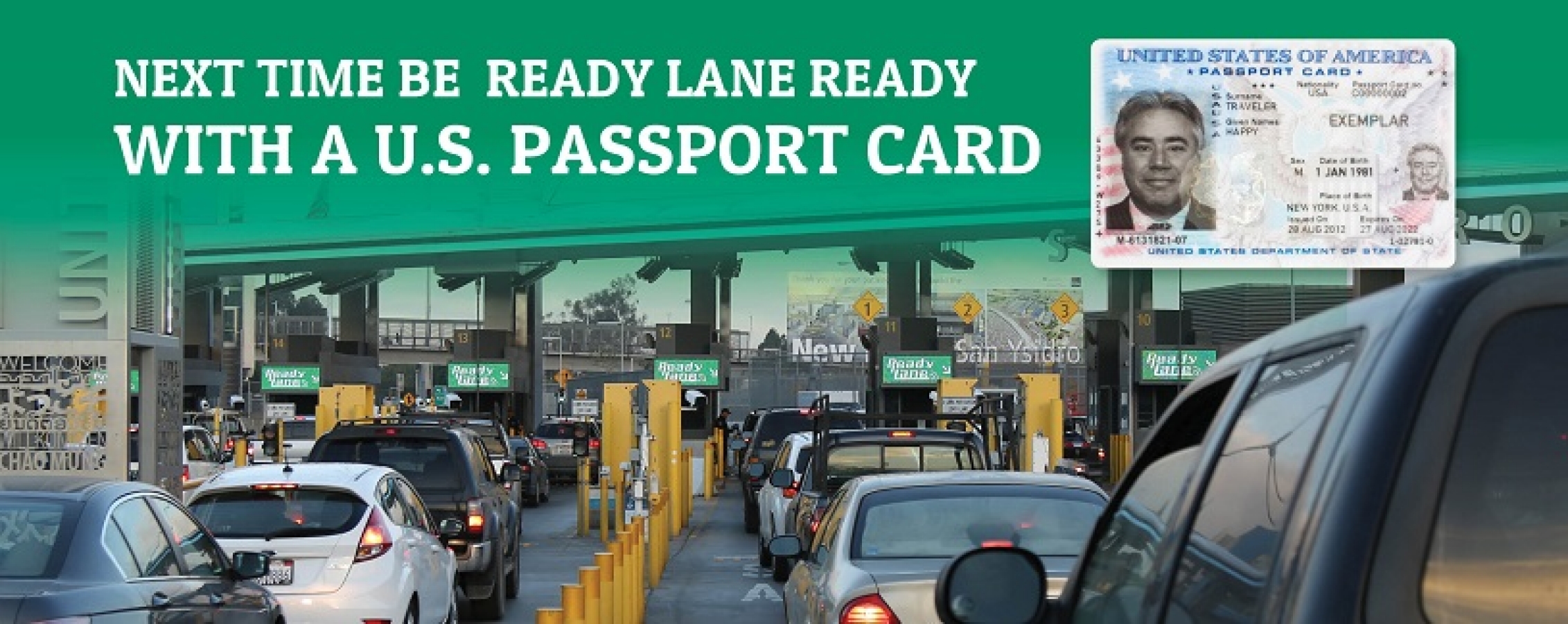
External Link
You are about to leave travel.state.gov for an external website that is not maintained by the U.S. Department of State.
Links to external websites are provided as a convenience and should not be construed as an endorsement by the U.S. Department of State of the views or products contained therein. If you wish to remain on travel.state.gov, click the "cancel" message.
You are about to visit:
From August 1, 2024, Onward: What Your Dog Needs to Enter the United States
At a glance.
Starting on August 1, 2024, dogs entering or returning to the United States must meet new, specific requirements depending on where they have been in the 6 months before entering the U.S. and where they received their rabies vaccines (if required).
Requirements for all dogs
Requirements for dogs with a current and valid rabies vaccination administered in the united states.
- Requirements for foreign-vaccinated dogs that have been in a country with high risk of dog rabies within 6 months before entry
Requirements for dogs that have been ONLY in countries that are dog rabies-free or low-risk during the 6 months before entry
All dogs must:
- Be at least 6 months of age at time of entry or return to the United States
- This must have been implanted prior to any required rabies vaccination
- The microchip number must be documented on all required forms and in all accompanying veterinary records
- Dogs may not enter the United States if they are carrying a disease contagious to people.
- Isolation of the dog, veterinary examination, and additional testing, at the importer’s expense, may be required to determine if the dog has a contagious disease and prevent spread if the dog does not appear healthy upon arrival.

This form should be filled out online ideally 2-10 days before arrival; however, it can also be completed right before travel (even in line at the border crossing) if you have internet access. If the information on the form changes before the dog arrives, you must submit a new form and indicate you are making changes to an existing form. All information, including port of entry where the dog is arriving, must be correct at time of arrival.
- This form requires you to upload a clear photograph of the dog showing its face and body. Dogs that will be less than one year of age at time of arrival should have the photograph taken within 10 days before arrival.
- There is no charge to importers for submitting this form.
- Additional requirements for dogs with a current rabies vaccination administered in the United States
- Additional requirements for dogs that have been in a country at high-risk for dog rabies within the 6 months before entry and do NOT have appropriate documentation of current US-issued rabies vaccine
- Additional requirements for dogs that have been ONLY in countries that are dog rabies-free or low-risk in the 6 months before entry
Dogs that do not meet all entry requirements or do not have accurate and valid forms will be denied entry to the United States and returned to the country of departure at the importer’s expense. These requirements apply to all dogs, including service dogs and dogs that were born in the United States.
Specific requirements depend on whether the dog has been in a high-risk country for dog rabies in the past 6 months.
Dogs with a current rabies vaccination administered in the United States that have been in a high-risk country for dog rabies must:
- Meet all requirements in the “All Dogs” section above
- The Certification of U.S.-issued Rabies Vaccination form is required for the importation (re-entry) of U.S.-vaccinated dogs that have been in high-risk countries for dog rabies within the 6 months before re-entry into the United States.
- Please note, during the transition period, the importer may instead present a copy of the USDA endorsed export health certificate that was used to ship the dog from the United States, if that export health certificate documents the dog’s age (at least 6 months), the microchip number, and valid rabies vaccination administered in the United States. The rabies vaccination must be valid (not expired) on the date of return or the form will be invalid.
- Arrive at the location listed on the CDC Dog Import Form receipt (This can be any airport, land border crossing, or sea port but you must select this location when you complete the CDC Dog Import Form.)
Dogs with a current rabies vaccination administered in the United States that have NOT been in a high-risk country in the last 6 months must:
- A Certification of U.S.-Issued Rabies Vaccine form that was endorsed by USDA before the dog departed the United States; or
- Document a valid (unexpired) rabies vaccination administered in the United States (the form will be valid for the duration of the rabies vaccination (1 or 3 years)).
- Arrive at the location listed on the CDC Dog Import Form receipt (This can be any airport, land border crossing, or sea port but you must select this location when you complete the CDC Dog Import Form .)
Important information about the Certification of U.S.-Issued Rabies Vaccination Form
The Certification of U.S.-Issued Rabies Vaccination form must be completed before the dog departs the U.S. Before asking your veterinarian to complete this form, verify the following requirements will be met:
- Ensure your dog will be at least 6 months of age on date of return to the U.S.
- Have your dog microchipped with an International Organization for Standardization (ISO)-compatible microchip (implanted before any required rabies vaccinations)
- Ensure the veterinarian scans the dog for the ISO-compatible microchip and records the microchip number at the time of vaccine appointment. Rabies vaccines administered prior to microchip implantation will not be considered valid.
- Ensure the rabies vaccination will be valid for the entire duration of your travels. If your dog’s U.S.-issued rabies vaccination lapses while overseas and your dog has been in a high-risk country in the past 6 months, your dog will need to be revaccinated overseas and meet requirements for foreign-vaccinated dogs to return to the U.S., including having a rabies serology titer, arriving at a specific port of entry, and possible quarantine requirements.
- Your dog’s first rabies vaccination must be administered at least 28 days before travel.
- Ensure the veterinarian submits this form to the USDA for official endorsement through the VEHCS portal
- Your dog must travel with a printed copy of the official endorsed form upon your dog’s return to the United States if your dog has been in a high-risk country within the 6 months before returning to the U.S.
During the transition period, U.S.-vaccinated dogs that have been in a high-risk country in the past 6 months, may have either the Certification of U.S.-Issued Rabies Vaccination form or the USDA endorsed export health certificate for re-entry into the United States. Without one of these forms your dog will need to meet the requirements specific to the risk category of the countries where they have been in the 6 months before returning to the United States.
The export health certificate must document the dog’s age (at least 6 months), microchip number, and the rabies vaccination date. The rabies vaccine must be valid (not expired) on the date of return or the form will be invalid.
Requirements for foreign-vaccinated dogs that have been in a country with high risk of dog rabies within 6 months before entry
Dogs, including service dogs, that have been in a country at high-risk for dog rabies within the 6 months before entry and do not have appropriate documentation of current U.S.-issued rabies vaccine must:
- Meet all requirements in the “All Dogs” section
- Ensure the dog is microchipped with an International Organization for Standardization (ISO)-compatible microchip before receiving the rabies vaccination and the number is recorded on the veterinary documents or the vaccine will not be considered valid
- Verify the dog is at least 12 weeks (84 days) of age when vaccinated against rabies
- The dog must have a valid (i.e., non-expired) rabies vaccination. If it’s the dog’s first vaccination or if the dog’s vaccination coverage has lapsed, the vaccine must be administered at least 28 days before arrival to the United States.
- The Certification of Foreign Rabies Vaccination and Microchip form must be completed by your veterinarian AND endorsed by an official veterinarian in the exporting country.
- The blood sample for the rabies serology titer must have been drawn at least 30 days after the dog’s first valid rabies vaccination and at least 28 days before entry to the U.S.
- Dogs with a history of multiple valid rabies vaccinations administered after the microchip was placed may have the sample for the rabies serology titer drawn at any time after a rabies booster vaccination as long as the dog’s first vaccine was given at least 30 days before the blood sample was drawn and there has been no lapse in vaccine coverage. If a lapse occurs, the sample must be drawn at least 30 days after the valid booster vaccination was administered.
- The sample must be sent to a CDC-approved rabies serology laboratory . If there is no CDC-approved laboratory in your country, your veterinarian may draw the sample and send it internationally to a CDC-approved laboratory.
- Passing results must be obtained in order for a serology to be valid.
- Rabies serology titer results will be considered valid for the life of the dog as long as the dog’s rabies vaccination coverage does not lapse. If a lapse occurs, a new rabies serology titer will be required and that sample must be drawn at least 30 days after the new vaccination was administered.
- If the dog does not have a valid rabies serology titer, it will be required to be quarantined at a CDC-registered animal care facility for 28 days after the dog is revaccinated by the facility’s veterinarian.
- All foreign-vaccinated dogs that have been in a high-risk country in the previous 6 months must have a reservation for examination, verification of age, documents, and microchip number, and administration of a rabies booster vaccination at a CDC-registered animal care facility immediately upon arrival in the United States.
- Dogs that do not have a valid rabies serology titer must also have a reservation for quarantine. Dogs will be quarantined at the facility for 28 days at the importer’s expense after being revaccinated by the facility’s veterinarian.
- All CDC-registered animal care facility expenses, including exam, revaccination, and quarantine (if required), are the responsibility of the importer.
- The facility will need copies of all required documents prior to confirming your reservation.
- Ensure the dog meets any facility-specific requirements (contact facility for additional information).
- If after arrival the CDC-registered animal care facility determines that your documents are not valid or the dog’s microchip number, age, or description does not match the paperwork provided, the dog may be denied entry and returned to the country of departure at your expense.
- Dogs that have evidence of illness or are not healthy will be required to have testing to confirm they do not have contagious diseases before they will be eligible for release, which may extend the required quarantine period beyond 28 days. Any required testing or extended stay in quarantine will be at the importer’s expense, so please ensure dogs are healthy upon arrival (including no evidence of fleas, ticks, or skin diseases).
- Dogs must arrive to the U.S. at the airport where the CDC-registered animal care facility is located. This must be the location where the dog has a reservation.
- This must also be the airport listed on the CDC Dog Import Form
- Domestic flights or other forms of travel to other locations in the U.S. are not permitted until after the dog receives required follow-up services at the CDC-registered animal care facility and is cleared for entry.
- SERVICE DOGS ARRIVING BY SEA : Service dogs, as defined in 14 CFR 382.3, may arrive by sea if they meet the requirements in the “All Dogs” section, have a complete Certification of Foreign Rabies Vaccination and Microchip form and a valid rabies serology titer, and are traveling with their handler. Emotional support animals are not service animals under this definition.
Countries that are not on the list of countries at high risk for dog rabies are considered to be free of or low risk for dog-mediated rabies virus variant (DMRVV) (called dog rabies-free or low-risk countries on these webpages).
Dogs, including service dogs, that have been ONLY in dog rabies-free or low-risk countries during the 6 months before entry into the United States must:
- Certification of Foreign Rabies Vaccination and Microchip form, including the endorsement by an official veterinarian of the dog rabies-free or low-risk country where the dog has been located; AND EITHER (1) a valid rabies serology titer OR (2) veterinary records* (which list the microchip number) for the dog from the exporting country for the previous 6 months. The form must be completed within 30 days before arrival to the United States.
- Certification of U.S.-Issued Rabies Vaccination form that was endorsed by USDA before the dog departed the United States
- Is for the dog rabies-free or low-risk country where the dog’s return itinerary originated (the form will only be valid for 30 days if it does not contain rabies vaccination information), or
- Documents a valid (unexpired) rabies vaccination administered in the United States (the form will be valid for the duration of the rabies vaccination (1 or 3 years)).
- Certification of Dog Arriving from DMRVV-free or Low-Risk Country into the United States form endorsed by an official veterinarian in the exporting country; AND veterinary records* (which list the microchip number) for the dog from the exporting country for the 6 months before traveling to the U.S. The form must be completed within the 30 days before arriving to the United States.
- Foreign export certificate that documents the dog is at least 6 months of age, lists the dog’s International Organization for Standardization (ISO)-compatible microchip number, and has been endorsed by an official veterinarian of the exporting country; AND veterinary records* (which list the microchip number) for the dog from the exporting country for the previous 6 months
- Arrive at the location listed on the CDC Dog Import Form receipt (This can be any airport, land border crossing, or sea port but you must select it when you complete the CDC Dog Import Form .)
Any documentation that is not from the United States must be completed in the country where the dog’s travel originates. For example, if the dog’s documents were issued in France, the dog may not enter the U.S. via a land-border crossing from Mexico to the U.S.
*Examples of veterinary records that must accompany completed forms are European Union pet passports or proof of payment for veterinary services received in the exporting low-risk country for the previous 6 months. Records must include the dog’s microchip number.
For more information, see: Frequently Asked Questions on CDC Dog Importations
If you have questions or need more information, please contact CDC-INFO at (800) 232-4636.
- Travelers' Health
- Healthy Pets Healthy People
- Southern Border Health and Migration
- Port Health
- Division of Global Migration Health
To receive email updates about this page, enter your email address:
Exit Notification / Disclaimer Policy
- The Centers for Disease Control and Prevention (CDC) cannot attest to the accuracy of a non-federal website.
- Linking to a non-federal website does not constitute an endorsement by CDC or any of its employees of the sponsors or the information and products presented on the website.
- You will be subject to the destination website's privacy policy when you follow the link.
- CDC is not responsible for Section 508 compliance (accessibility) on other federal or private website.

8 tips for Canadians travelling to Mexico in 2024, from entry rules to tipping etiquette
P lanning a trip to Mexico? Whether you want to explore Mayan ruins and hidden cenotes or lounge on white-sand beaches at an a ll-inclusive resort , there are certain things you'll want to keep in mind before embarking on your trip.
Canadians booking a vacation in Mexico will want to be aware of the country's entry and exit requirements, what travel documents they'll need and the current travel advice from the Government of Canada .
To help, we've laid out a few essentials you'll want to keep in mind, whether you're jetting off to Cancun, Mazatlan, Tulum or Mexico City.
From the ideal times to visit, to regions to avoid and requirements for your Canadian passport, here are eight tips for preparing for your next Mexican holiday.
Know when to visit
www.instagram.com
Details: Before booking that trip to Mexico, you'll want to make sure you're going at a time with good weather.
However, the best time to visit varies depending on where in the country you're visiting. According to the U.S. News & World Report, if you're travelling to Cancun , the best time to visit would be from December to April, when you'll get to enjoy "near-perfect weather."
If you're visiting Mexico City , the best time to visit is between March and May, as the city's winters can be chilly and the summers can be rainy.
According to the Government of Canada, hurricanes usually occur in Mexico from mid-May to the end of November, so keep this in mind when booking your trip.
To figure out when to go, you can use a travel platform like KAYAK's Best Time To Travel Tool , which uses your origin, destination and length of trip to determine when you should travel and when to book for a great price.
Find out more
Know the entry requirements
Details: Canadians can visit Mexico as a tourist for up to 180 days, or six months, without needing a visa. An immigration official will determine the number of days you can remain in Mexico.
Travellers must have a valid passport that will be valid for the expected duration of their stay in the country. They must also obtain and complete a tourist card to enter the country.
According to the Government of Canada, if entering Mexico by air, you are advised to download your tourist card issued by Mexican officials upon entry.
Depending on your airport of entry, the immigration official will stamp your passport and note the number of days you are allowed to spend in Mexico, or you'll go through an E-gate kiosk where you will scan your passport and self-register your entry into the country.
Once in the country, whether you entered via an E-gate or not, you will be able to access the digital tourist card online. You'll have 60 days to download it.
According to the government, travellers who don’t obtain a tourist card upon arrival may face a fine, detention or even expulsion.
Take note of Canada's travel advice
Details: The Government of Canada continues to advise that Canadians exercise a high degree of caution in Mexico due to high levels of criminal activity and kidnapping.
"Levels of crime, particularly violent crime, are high throughout Mexico. Arrest and detention rates are low and don’t deter criminal activity," says Canada's travel advisory for Mexico.
"There are high rates of violent crime, such as homicides, kidnappings, carjacking and assaults, including in popular tourist destinations such as the Mayan Riviera (Cancún, Playa del Carmen, Puerto Morelos and Tulum), and Acapulco."
The government advises that travellers remain vigilant at all times while in the country, stay in tourist areas, be very cautious on major highways, avoid travelling at night and monitor local media closely.
Avoid drinking the tap water
Details: You may want to avoid the tap water while in Mexico.
According to Yale University's Environmental Performance Index , which scores countries based on how safe their drinking water is, Mexico's drinking water isn't as safe as that of other countries.
The index measures unsafe drinking water using the number of age-standardized disability-adjusted life-years lost per 100,000 persons in a country (also known as the DALY rate) due to exposure to unsafe drinking water.
A score of 100 indicates a country has among the lowest DALY rates in the world, while a score of 0 indicates a country is among the highest. In its most recent index , Mexico received a DALY score of 50.
The U.S. Government advises citizens that in many areas in Mexico, tap water is "not potable."
"Bottled water and beverages are safe, although you should be aware that many restaurants and hotels serve tap water unless bottled water is specifically requested. Be aware that ice for drinks might be made using tap water," says the government.
The Government of Canada also advises travellers to avoid inhaling or swallowing water while bathing or showering.
CAA Quebec recommends that travellers purchase bottled purified water to drink and brush their teeth with instead of using tap water.
Know the currency rules
Details: The official currency of Mexico is the Mexican peso. According to the Government of Canada, in some parts of Mexico, particularly tourist destinations, hotels and other service providers may advertise prices in USD.
Sunwing recommends that travellers bring USD as it is widely accepted around the island.
If you plan to bring USD, be aware that there is a limit to the amount of U.S. dollars that residents and foreigners can exchange in Mexico, depending on their immigration status.
According to the Government of Canada, when carrying more than US$10,000 or the equivalent in other currencies, cash, cheques, money orders or any other monetary instrument, you must declare the amount exceeding US$10,000.
Failure to do this is against Mexican law and often results in detention.
Know when to tip
Details: As in Canada, tipping is expected in most parts of Mexico.
According to group travel company Intrepid Travel , which operates tours to Mexico, Mexican service workers typically earn a low wage and rely on tips to earn a decent living.
The company recommends travellers leave 10 to 15 percent at restaurants (if the service charge is not already included), 5 to 10 percent of the hotel room cost for housekeepers, and a few dollars for porters, bartenders and guides.
According to Skyscanner , it's always best to tip in cash, using Mexican pesos rather than any foreign currency.
The company notes that while some all-inclusive resorts in Mexico have no-tipping policies, if an employee has excelled in their performance, a tip is a nice way to show your appreciation.
Taxi drivers and airport shuttle operations in Mexico will not expect a tip, according to the travel company. However, if your driver helps you with your luggage or the shuttle operator helps with your bags, it is courteous to tip around 10 pesos.
Avoid certain areas
Details: Canadians travelling to Mexico will want to take note of warnings to avoid certain parts of the country.
The Government of Canada continues to advise Canadians to avoid all travel to Guerrero State due to the region's precarious security situation.
The state is home to the Mexican city of Acapulco, a popular vacation spot.
According to the advisory, there is a threat of armed violence, banditry, and looting in cities and on roads in the state. The advisory excludes, however, the cities of Ixtapa/Zihuatanejo and Taxco, where travellers should "exercise a high degree of caution."
There are also regional advisories in place warning Canadians to avoid non-essential travel to several Mexican states due to high levels of violence and organized crime, including Chihuahua, Colima, Coahuila, Durango, Michoacán, Nuevo León, Sinaloa, Tamaulipas and Zacatecas.
The Government of Canada also advises Canadians to avoid border areas, which often see higher criminal activity and violence, such as shootouts, attacks and illegal roadblocks.
The government recommends travelling to Mexico by air to avoid international land border crossings, particularly along the border with the U.S., in Ciudad Juárez, Nuevo Laredo and Reynosa.
Pay the tourism tax
Details: If travelling to the state of Quintana Roo in Mexico (including popular destinations like Cancun, Cozumel, Playa Del Carmen, Riviera Maya and Tulum), travellers will have to pay a tourist tax known as VisiTAX.
The payment of the VisiTAX is a legal requirement to leave the State of Quintana Roo, and is not included in the price of the plane tickets or any other service such as hotel reservations, vacation packages, ground transportation, or tours, according to Cancun Airport .
The tax costs US$20.99 (about CA$28.40) per person, and is to be paid online. Travellers can pay this fee prior to their arrival or during their stay, and must show their receipt at the airport before leaving Mexico.
According to Cancun Airport, your payment and your VisiTAX code will be synchronized with your travel documents for an easy transition through the airport checkpoints.
Payment can only be made online via the VisiTAX website , according to Air Transat .
Bon voyage!
Before you get going, check out our Responsible Travel Guide so you can be informed, be safe, be smart, and most of all, be respectful on your adventure.
This article's cover image was used for illustrative purposes only.
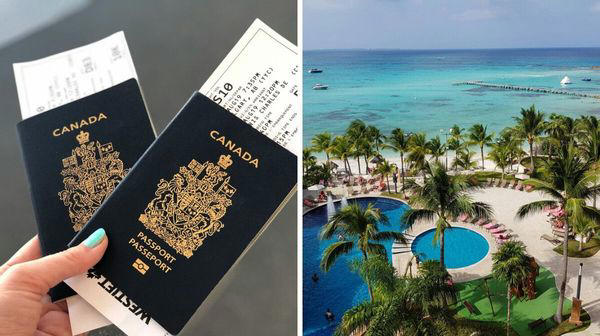
CDC issues Mexico travel advisory after suspected fungal meningitis infections

The Centers for Disease Control and Prevention has issued a travel advisory after some U.S. residents were diagnosed with suspected fungal meningitis infections following medical or surgical procedures in Mexico.
The infections were contracted after procedures in Matamoros, which is located on the Texas border, and have led to serious illness and death, the agency said. The Level 2 advisory urged travelers to “practice enhanced precautions.”
The Texas Department of State Health Services also issued an alert Tuesday and said an investigation had identified at least five patients. One has died, while four are hospitalized, according to a news release .
“Travelers with these infections had medical or surgical procedures (including liposuction) that involved injection of an anesthetic into the area around the spinal column (i.e., epidural) performed at clinics in Matamoros, including River Side Surgical Center and Clinica K-3,” the CDC said.
Medical tourism: Why do people in the U.S. cross the border into Mexico for health care?
Learn more: Best travel insurance
Traveling abroad for cosmetic surgery: Why are more people doing it, and what are the risks?
The two clinics did not immediately respond to USA TODAY’s request for comment.
The CDC urged travelers who have had procedures in Matamoros that involved an epidural infection of an anesthetic since Jan. 1 to monitor themselves for symptoms and to consider seeking medical advice. Those who experience symptoms should “immediately” go to a hospital emergency department, the CDC said.
The symptoms of fungal meningitis include fever, stiff neck, headache, confusion, nausea, vomiting and sensitivity to light. While anyone can contract it, the infection is not contagious and can be treated with IV and oral medications. People with weakened immune systems are at higher risk of infection.
“Cancel any procedure that involves an epidural injection of an anesthetic in Matamoros, Mexico, until there is evidence that there is no longer a risk for infection at these clinics,” the agency added.
Travel from the U.S. to Mexico for medical care is common.
"Medical tourism has been a very big part of the border communities for many, many, many years," Ricardo Ainslie, a professor at the University of Texas at Austin and director of research and education at the health care partnership AMPATH Mexico, told USA TODAY in March. "It's primarily driven by the fact that it's easy to get appointments and that it's much less expensive.”
Medical tourism can be risky, and various factors can increase the chance of complications, including varying quality of care and difficulty communicating through language barriers, according to the CDC . The agency recommends taking steps such as researching the healthcare providers and facility ahead of time and purchasing travel health insurance that covers medical evacuation.
Nathan Diller is a consumer travel reporter for USA TODAY based in Nashville. You can reach him at [email protected].
Mexico Tightens Travel Rules on Peruvians in a Show of Visa Diplomacy to Slow Migration to US
Mexico has begun requiring visas for Peruvians in response to a major influx of migrants from the South American country

Gregory Bull
Peruvian Julia Paredes, left in white hat, listens to instructions from a Border Patrol agent with others seeking asylum as they wait to be processed after crossing the border with Mexico nearby, Thursday, April 25, 2024, in Boulevard, Calif. Mexico has begun requiring visas for Peruvians in response to a major influx of migrants from the South American country. The move follows identical ones for Venezuelans, Ecuadorians and Brazilians, effectively eliminating the option of flying to a Mexican city near the U.S. border. (AP Photo/Gregory Bull)
BOULEVARD, Calif. (AP) — Julia Paredes believed her move to the United States might be now or never. Mexico was days from requiring visas for Peruvian visitors. If she didn't act quickly, she would have to make a far more perilous, surreptitious journey over land to settle with her sister in Dallas.
Mexico began requiring visas for Peruvians on Monday in response to a major influx of migrants from the South American country, after identical moves for Venezuelans, Ecuadorians and Brazilians. It effectively eliminated the option of flying to a Mexican city near the U.S. border, as Paredes, 45, did just before it was too late.
“I had to treat it as a emergency,” said Paredes, who worked serving lunch to miners in Arequipa, Peru, and borrowed money to fly to Mexico's Tijuana, across from San Diego. Last month smugglers guided her through a remote opening in the border wall to a dirt lot in California , where she and about 100 migrants from around the world shivered over campfires after a morning drizzle and waited for overwhelmed Border Patrol agents to drive them to a station for processing.
Senior U.S. officials, speaking to reporters ahead of a meeting of top diplomats from about 20 countries in the Western hemisphere this week in Guatemala, applauded Mexico's crackdown on air travel from Peru and called visa requirements an important tool to jointly confront illegal migration.
For critics, shutting down air travel only encourages more dangerous choices. Illegal migration by Venezuelans plummeted after Mexico imposed visa requirements in January 2022, but the lull was short-lived. Last year Venezuelans made up nearly two-thirds of the record-high 520,000 migrants who walked through the Darien Gap, the notorious jungle spanning parts of Panama and Colombia.
More than 25,000 Chinese traversed the Darien last year. They generally fly to Ecuador, a country known for few travel restrictions, and cross the U.S. border illegally in San Diego to seek asylum. With an immigration court backlog topping 3 million cases, it takes years to decide such claims, during which time people can obtain work permits and establish roots.
“People are going to come no matter what,” said Miguel Yaranga, 22, who flew from Lima, Peru's capital, to Tijuana and was released by the Border Patrol Sunday at a San Diego bus stop. He had orders to appear in immigration court in New York in February 2025, which puzzled him because he said he told agents he would settle with his sister on the other side of the country, in Bakersfield, California.
Jeremy MacGillivray, deputy chief of the Mexico mission of the U.N.'s International Organization for Migration, predicts that Peruvian migration will drop “at least at the beginning” and bounce back as people shift to walking through the Darien Gap and to Central America and Mexico.
Mexico said last month that it would require visas for Peruvians for the first time since 2012 in response to a “substantial increase” in illegal migration. Large-scale Peruvian migration to Mexico began in 2022; Peruvians were stopped in the country an average of 2,160 times a month from January to March of this year, up from a monthly average of 544 times for all of 2023.
Peruvians also began showing up at the U.S. border in 2022. The U.S. Border Patrol arrested Peruvians an average of about 5,300 times a month last year before falling to a monthly average of 3,400 from January through March, amid a broad immigration crackdown by Mexico .
Peru immediately reciprocated Mexico's visa requirement but changed course after a backlash from the country's tourism industry. Peru noted in its reversal that it is part of a regional economic bloc that includes Mexico, Chile and Colombia.
Adam Isacson, an analyst at the Washington Office on Latin America, said Peru's membership with Mexico in the Pacific Alliance allowed its citizens visa-free travel longer than other countries.
It is unclear if Colombia, also a major source of migration , will be next, but Isacson said Mexican President Andrés Manuel López Obrador is in a “lovefest” with his Colombian counterpart, Gustavo Petro, while his relations with Peru's government are more strained.
Colombians are consistently near the top nationalities of migrants arriving at Tijuana's airport. Many find hotels before a guide takes them to boulder-strewn mountains east of the city, where they cross through openings in the border wall and then walk toward dirt lots that the Border Patrol has identified as waiting stations.
Bryan Ramírez, 25, of Colombia, reached U.S. soil with his girlfriend last month, only two days after leaving Bogota for Cancun, Mexico, and continuing on another flight to Tijuana. He waited alongside others overnight for Border Patrol agents to pick him up as cold rain and high winds whipped over the crackle of high-voltage power lines.
The group waiting near Boulevard, a small, loosely defined rural town, included several Peruvians who said they came for economic opportunity and to escape violence and political crises.
Peruvians can still avoid the Darien jungle by flying to El Salvador, which introduced visa-free travel for them in December in reciprocation for a similar move by Peru's government. But they would still have to travel over land through Mexico, where many are robbed or kidnapped.
Ecuadoreans, who have needed visas to enter Mexico since September 2021, can also fly to El Salvador, but not all do. Oscar Palacios, 42, said he walked through Darien because he couldn't afford to fly.
Palacios, who left his wife and year-old child in Ecuador with plans to support them financially from the U.S., said it took him two weeks to travel from his home near the violent city of Esmeralda to Mexico's border with Guatemala. It then took him two months to cross Mexico because immigration authorities turned him around three times and bused him back to the southern part of the country. He said he was robbed repeatedly.
Palacios finally reached Tijuana and, after three nights in a hotel, crossed into the U.S. A Border Patrol agent spotted him with migrants from Turkey and Brazil and drove them to the dirt lot to wait for a van or bus to take them to a station for processing. Looking back on the journey, Palacios said he would rather cross Darien Gap 100 times than Mexico even once.
Associated Press writer Christopher Sherman in Mexico City contributed.
Copyright 2024 The Associated Press . All rights reserved. This material may not be published, broadcast, rewritten or redistributed.
Photos You Should See - May 2024

Join the Conversation
Tags: Associated Press , politics , immigration , world news , California
Related Articles
Best states.

America 2024

Best States Rankings
- # 2 New Hampshire
- # 3 Nebraska
- # 4 Minnesota
Health News Bulletin
Stay informed on the latest news on health and COVID-19 from the editors at U.S. News & World Report.
Sign in to manage your newsletters »
Sign up to receive the latest updates from U.S News & World Report and our trusted partners and sponsors. By clicking submit, you are agreeing to our Terms and Conditions & Privacy Policy .
You May Also Like
The 10 best states in america.
Elliott Davis Jr. May 7, 2024

Why Utah Is the Best State
Elliott Davis Jr. and Julia Haines May 7, 2024

Why Florida Is No. 1 in Education
Tim Smart May 7, 2024

Cargo Ship That Caused Baltimore Bridge Collapse Had Power Blackout Hours Before Leaving Port
Associated Press May 14, 2024

Veteran DEA Agent Sentenced to 3 Years for Bribing Former Colleague to Leak Intelligence

Alaska Budget Negotiators Announce Tentative Deal as Legislative Session Nears Deadline

Military Hearing Officer Deciding Whether to Recommend Court-Martial for Pentagon Leaker

Wisconsin GOP-Led Senate Votes to Override Nine Evers Vetoes in Mostly Symbolic Action

A Chicago Teen Entered College at 10. at 17, She Earned a Doctorate From Arizona State

Google Unleashes AI in Search, Raising Hopes for Better Results and Fears About Less Web Traffic


IMAGES
VIDEO
COMMENTS
Call us in Washington, D.C. at 1-888-407-4747 (toll-free in the United States and Canada) or 1-202-501-4444 (from all other countries) from 8:00 a.m. to 8:00 p.m., Eastern Standard Time, Monday through Friday (except U.S. federal holidays). See the State Department's travel website for the Worldwide Caution and Travel Advisories.
Arrivals to Mexico by air. If you are visiting Mexico and arriving by airplane, you must carry a current passport. Note that Passport Cards are not valid for air travel. We also recommend that your passport is valid for at least six months from the date of your arrival in Mexico. If your passport is expired the airlines will not allow you to ...
A full list of IDs you can use is below: A Valid Passport. Trusted Traveler Cards (NEXUS, SENTRI, or FAST) State Issued Enhanced Driver's License (when available) Enhanced Tribal Cards (when available) U.S. Military Identification with Military Travel Orders. U.S. Merchant Mariner Document when traveling in conjunction with official maritime ...
You will be asked for this document at your departure from Mexico. 3. Mexican immigration officers at the port of entry may request additional documents depending on the purpose/activity of your trip. Business: Letter in Spanish from your foreign company indicating that you are their employee and that you will not be paid by a Mexican company.
Mexico entry requirements for tourists and short term visitors Mexico Visitors Permit, FMM. Passport holders from countries on Mexico's no visa required list do not need to apply for a formal visa to visit Mexico. They may, instead, use a visitor's permit, known as a FMM (Forma Migratoria Multiple).For the countries that don't need a visa, a Mexico Visitor's Permit (FMM) is issued in ...
Key Takeaways: To travel to Mexico, you'll need a valid passport or passport card, a tourist card, and possibly a visa or residency permit.; It's recommended to have travel insurance and necessary driving documents if planning to drive in Mexico. Minors traveling without both parents should have a notarized letter of permission, and carrying copies of important documents is advisable.
The following items are considered valid identification documents for traveling to Mexico: A U.S. passport book (required for all international air travel to Mexico) A U.S. passport card. An enhanced driver's license (EDL) A trusted traveler program card (NEXUS card SENTRI card, FAST card, or Global Entry card)
Documents Required for a Mexico Visa. The documents you need to submit when applying for a Mexico visa include: A Mexico Visa Application Form. A valid passport or other travel documents. Photocopy of your passport. Passport-size pictures according to Mexico photo guidelines. Booked return travel ticket.
Report drug and alien smuggling. Call (956) 542-5811 in the U.S., 001800-0105237 from Mexico. Prohibited/Permissible Items. All articles acquired in Mexico must be declared. $800 exemption for gifts and personal articles, including one liter of alcoholic beverages per person over 21 every 30 days. Cuban cigars are prohibited.
Documents needed include a valid passport, valid FMM, valid tourist visa (if necessary) and proof of sufficient funds to remain in Mexico for the intended length of stay. If your FMM was issued for 180 days, you'll need to leave Mexico and re-enter - this triggers the issuance of a new FMM.
These documents are acceptable travel documents for all United States citizens. Passport card: Issued by the U.S. Department of State, this passport substitute is credit-card sized and valid for entry into Mexico by land or sea. The passport card is not accepted for air travel.
Foreigners must present a valid and original photo ID (photocopied and digital documents are not accepted) Passport. Residency. Another official photo ID. Minors may present any of the following: Birth certificate. Passport. Photocopied and digital documents are not accepted. Flights to Mexico.
What U.S. Citizens Need to Travel to Mexico. American citizens must have a few essential documents to travel to Mexico. These include: US passport. FMM tourist card (for land travel) Mexican visa (if applicable) A visa for Mexico may not be required for US passport holders. This depends on the period of stay and your reason for traveling.
If you hold a passport issued by one of the many countries on Mexico's " no visa required " list,* you don't need to apply for a visa to visit Mexico. You can, instead, complete a Visitor's Permit, also known as a FMM, at your port of entry. There is a ~US$25 fee for the permit, which is usually included in your airfare's "fees ...
Understand Mexico's visa rules: Most travelers don't need a visa, but a tourist card (FMM) is required for stays up to 180 days. Tourist Card (FMM): The FMM is mandatory for visa-exempt visitors and can be obtained upon arrival or online. Required documents: To obtain the FMM, you need a valid passport, completed FMM form, and proof of ...
Mexico has a liberal visa policy offering visa EXEMPTION to many nationalities. Those who REQUIRE a visa are also exempt from visa if they hold a valid visa from the US, UK, Canada, Schengen or Japan. Mexico visa application is fairly simple. It costs $44 USD and takes about two business days to process. Mexico tourist visa is valid for 180 ...
All EAD cards, I-797 A Forms, Advance Parole Forms, I-20 OR DS-2019 are not accepted to enter Mexico. Foreigners of any country traveling to Mexico on leisure trips visiting Mexican maritime ports by cruise, are not required to obtain a visa or consular stamp. The passenger must carry a valid and not expired passport or travel document.
The passport should be valid for, at minimum, 6 months from your time of arrival in country. All U.S. and Canadian citizens traveling by air or sea to Mexico are required to present a valid passport or other valid travel document to enter or reenter the United States except if returning from a closed-loop cruise.
Mentioned below are the documents needed to travel to Mexico by air. Tourists need a valid passport book to enter Mexico by air. However, those attempting to enter an airport with a US passport card may be denied admission. One of Mexico's essential travel requirements is to visit the National Migration Institute (INM) office to obtain an ...
Visitors to Mexico are required to carry their original passport—not a copy—at all times. If you received a paper FMM upon arrival, you are also required to keep that with you, and should be prepared to provide it to immigration authorities when you depart. Visitors not carrying their passport or who remain in Mexico beyond the authorized ...
Foreign citizens traveling to Mexico are issued an Official Entry Immigration Form (FMM) also known as Tourist Card. The online registration process is FREE, very convenient, straightforward, and to complete the process all you need is your passport and travel information. THE TOURIST CARD IS PER PERSON INCLUDING CHILDREN AND DIPLOMATIC ...
Leaving Mexico. To leave Mexico, you must show your passport with the stamp showing the number of days you were allowed to stay. If you lose your passport, you must pay a fee to replace the entry ...
U.S. citizens must present a valid U.S. passport book or card, and an entry permit issued by Instituto Nacional de Migración. Enter Mexico with valid proof of automobile registration, even if remaining in the border zone. Entering Mexico with an expired U.S. vehicle registration may lead to the confiscation of the auto by Mexican authorities.
Visit a veterinarian to get your dog its rabies vaccination (or booster) before travel. Rabies vaccination is not required if the dog has been only in dog rabies-free or low-risk countries for 6 months, but is strongly recommended. It may also be required by the U.S. state or territory to which the dog is traveling. 30 days before travel
Details: Canadians can visit Mexico as a tourist for up to 180 days, or six months, without needing a visa. An immigration official will determine the number of days you can remain in Mexico.
Travel from the U.S. to Mexico for medical care is common. "Medical tourism has been a very big part of the border communities for many, many, many years," Ricardo Ainslie, ...
Ecuadoreans, who have needed visas to enter Mexico since September 2021, can also fly to El Salvador, but not all do. Oscar Palacios, 42, said he walked through Darien because he couldn't afford ...